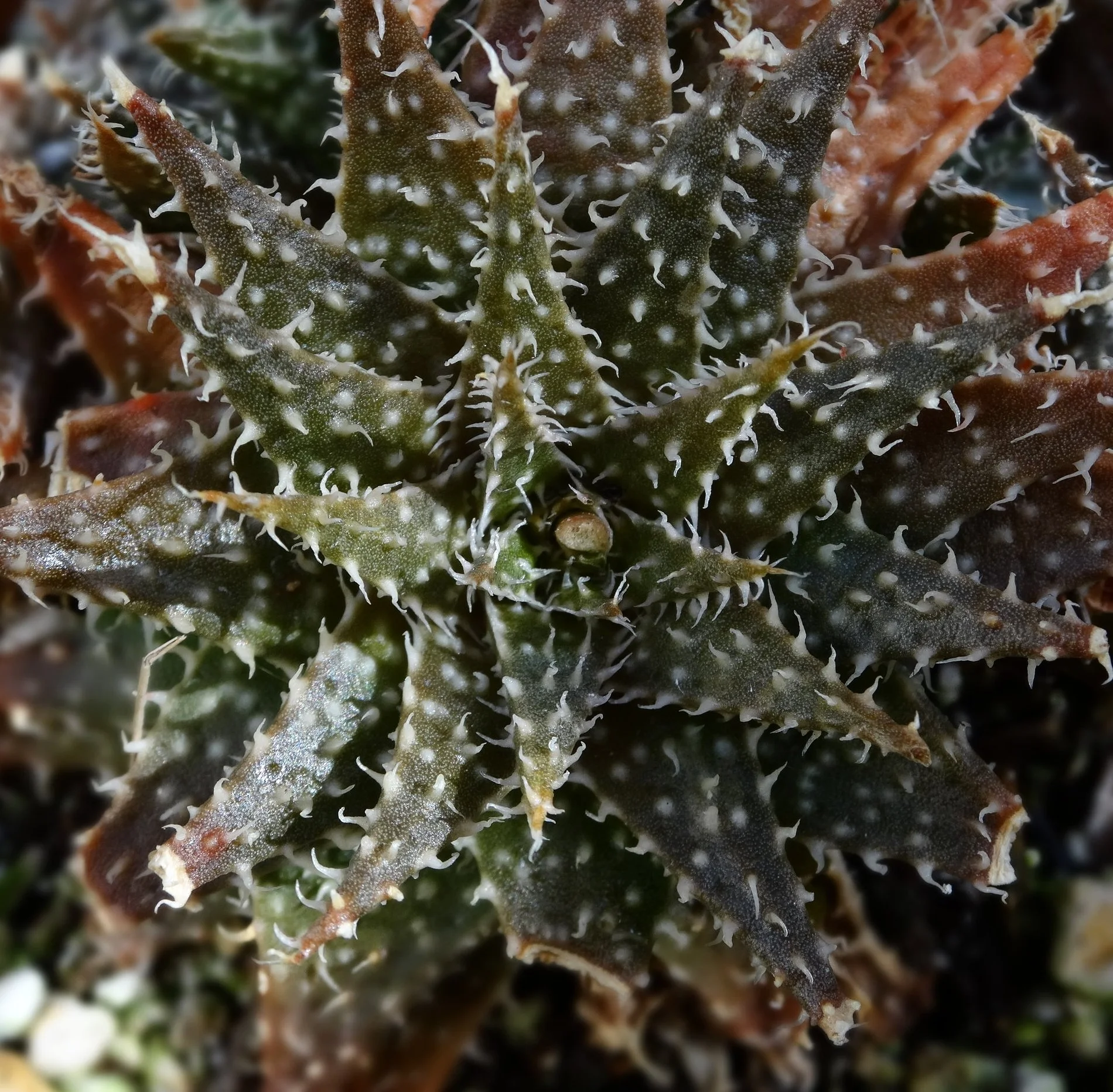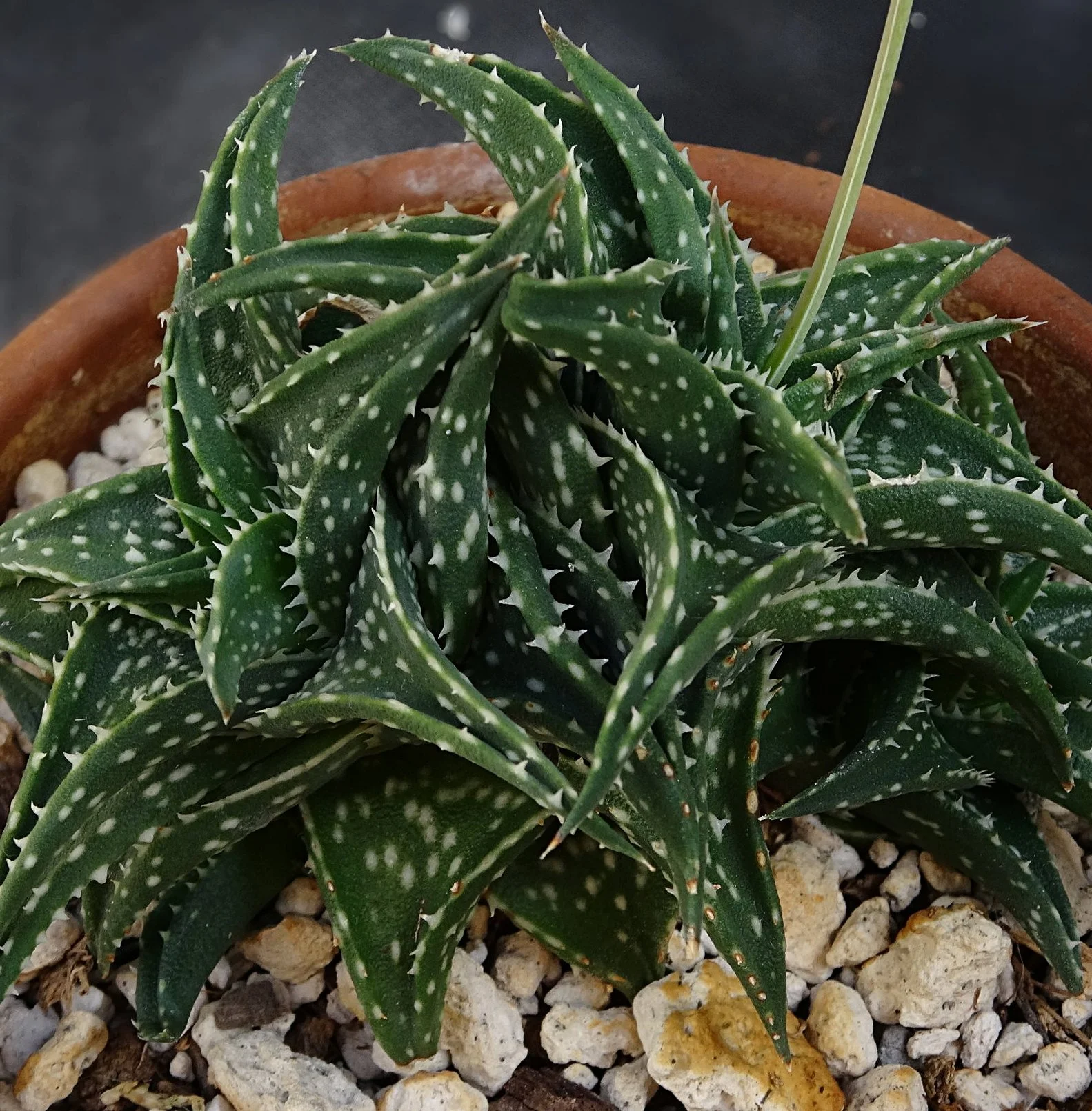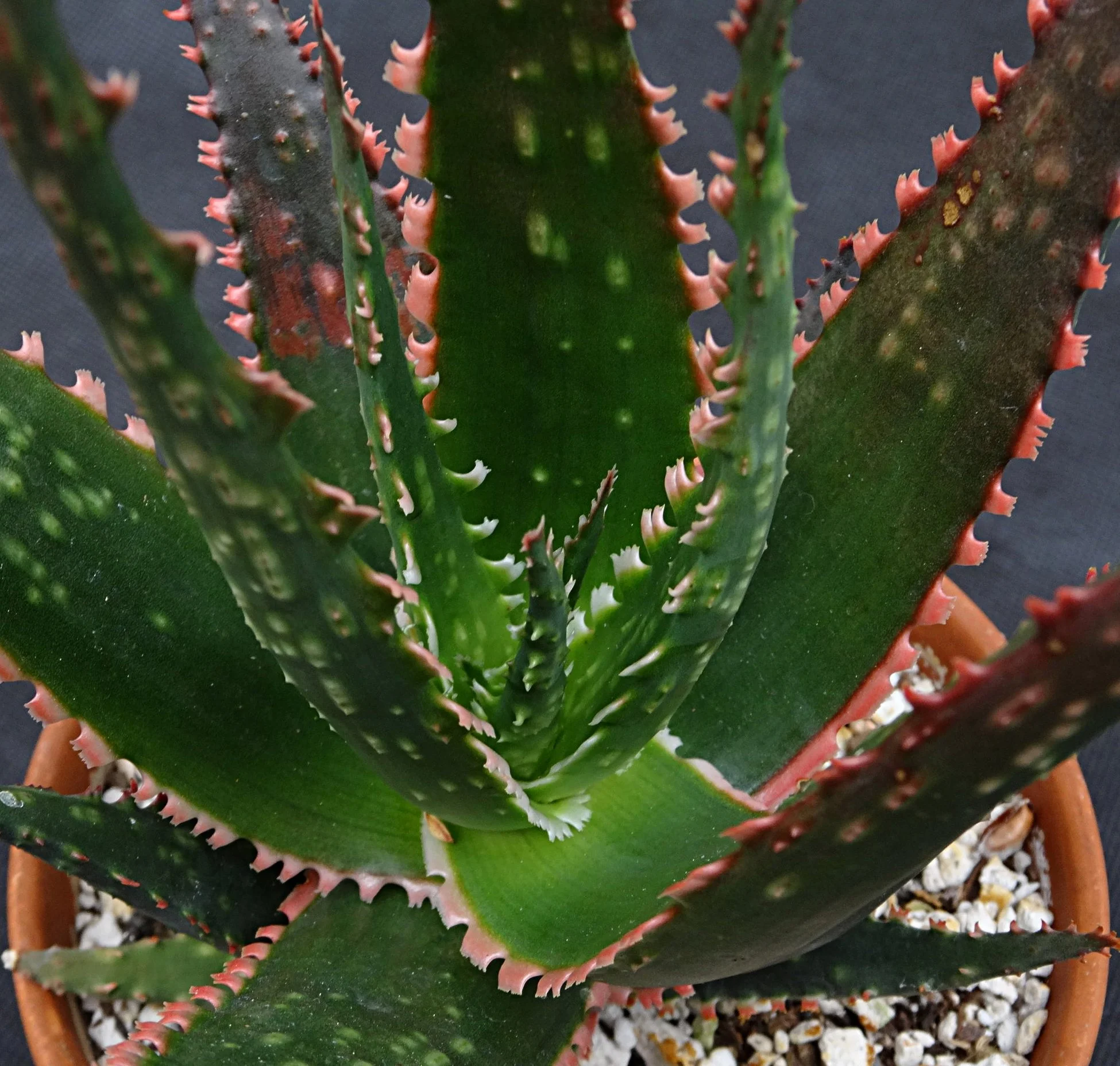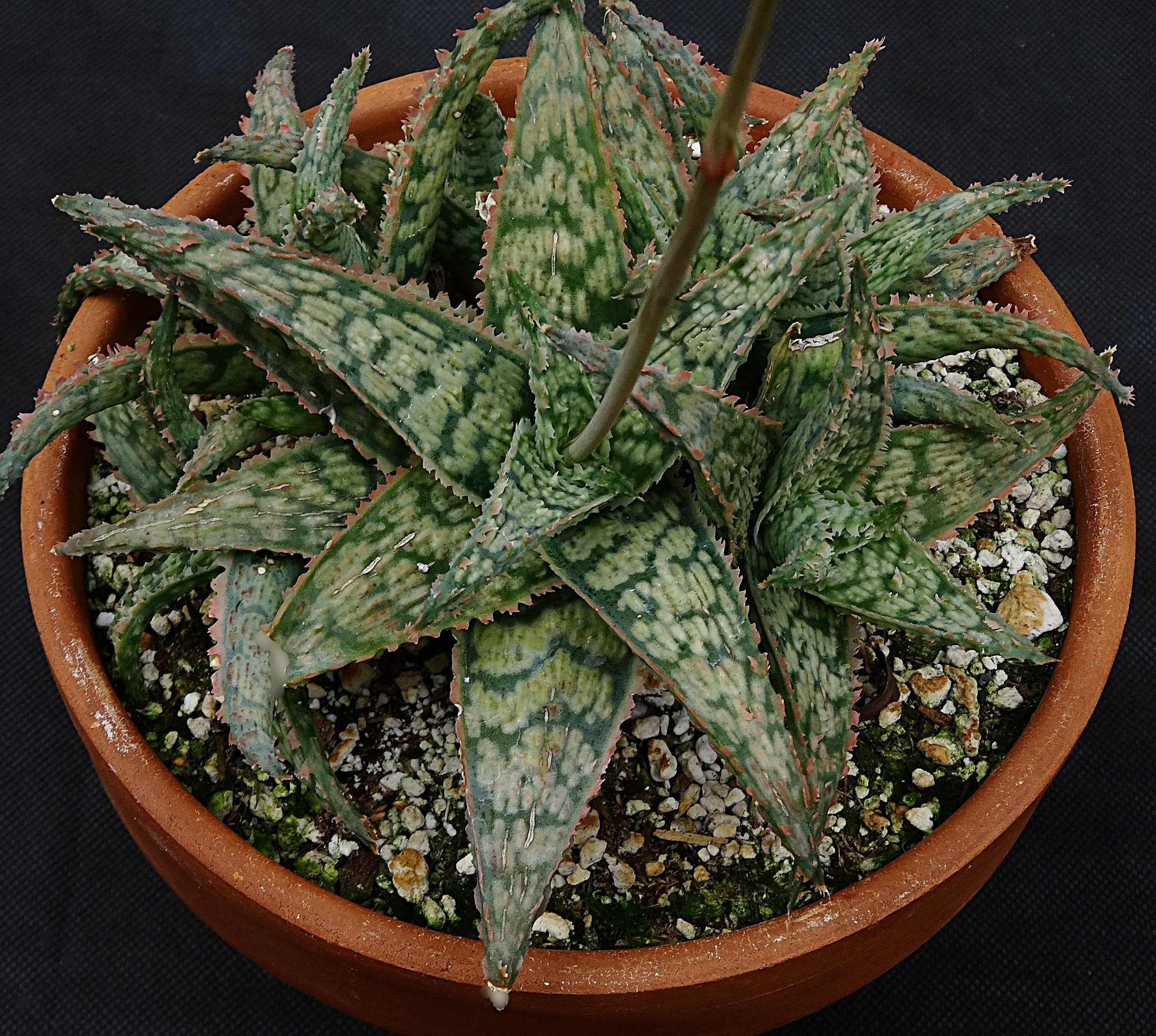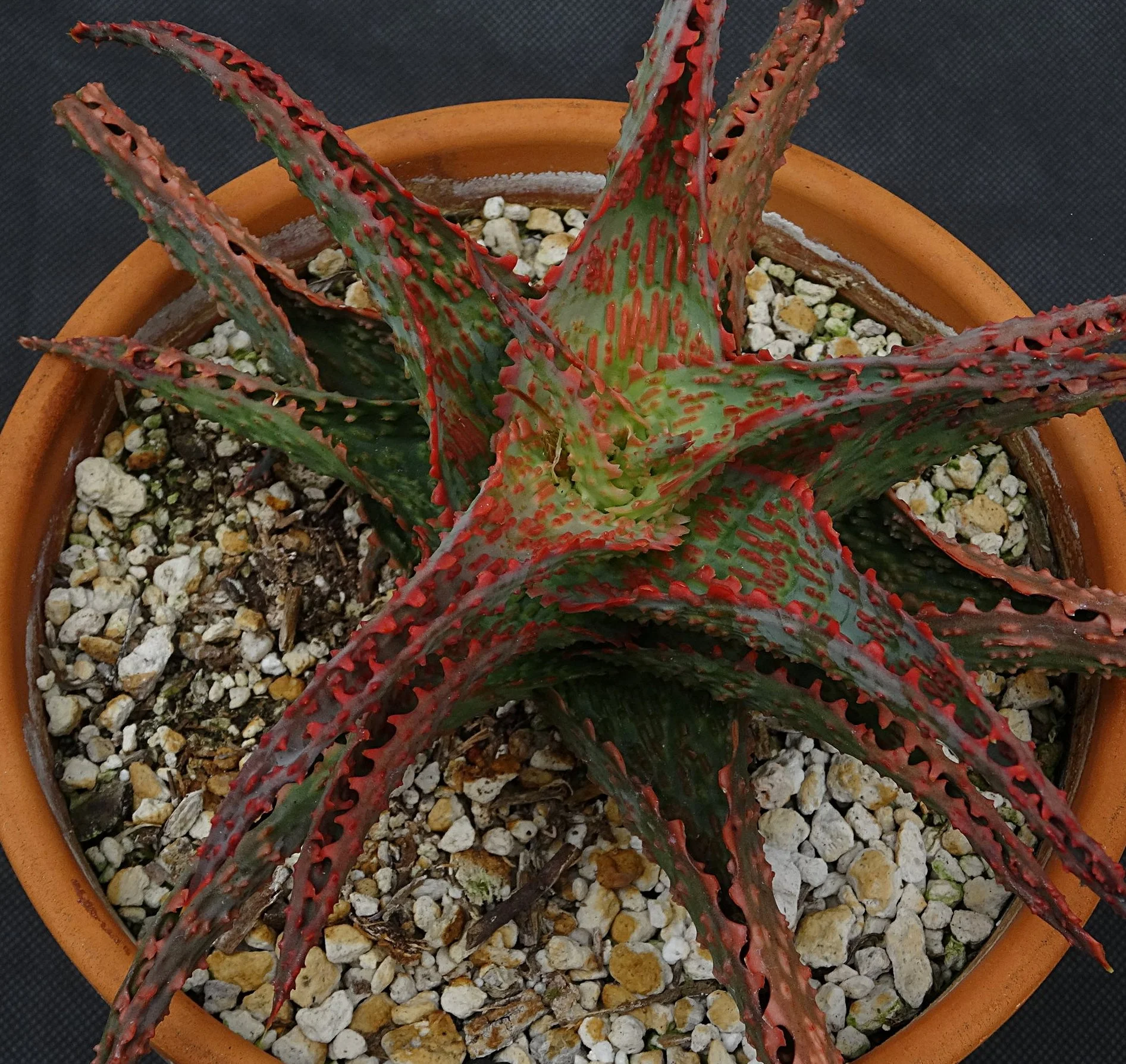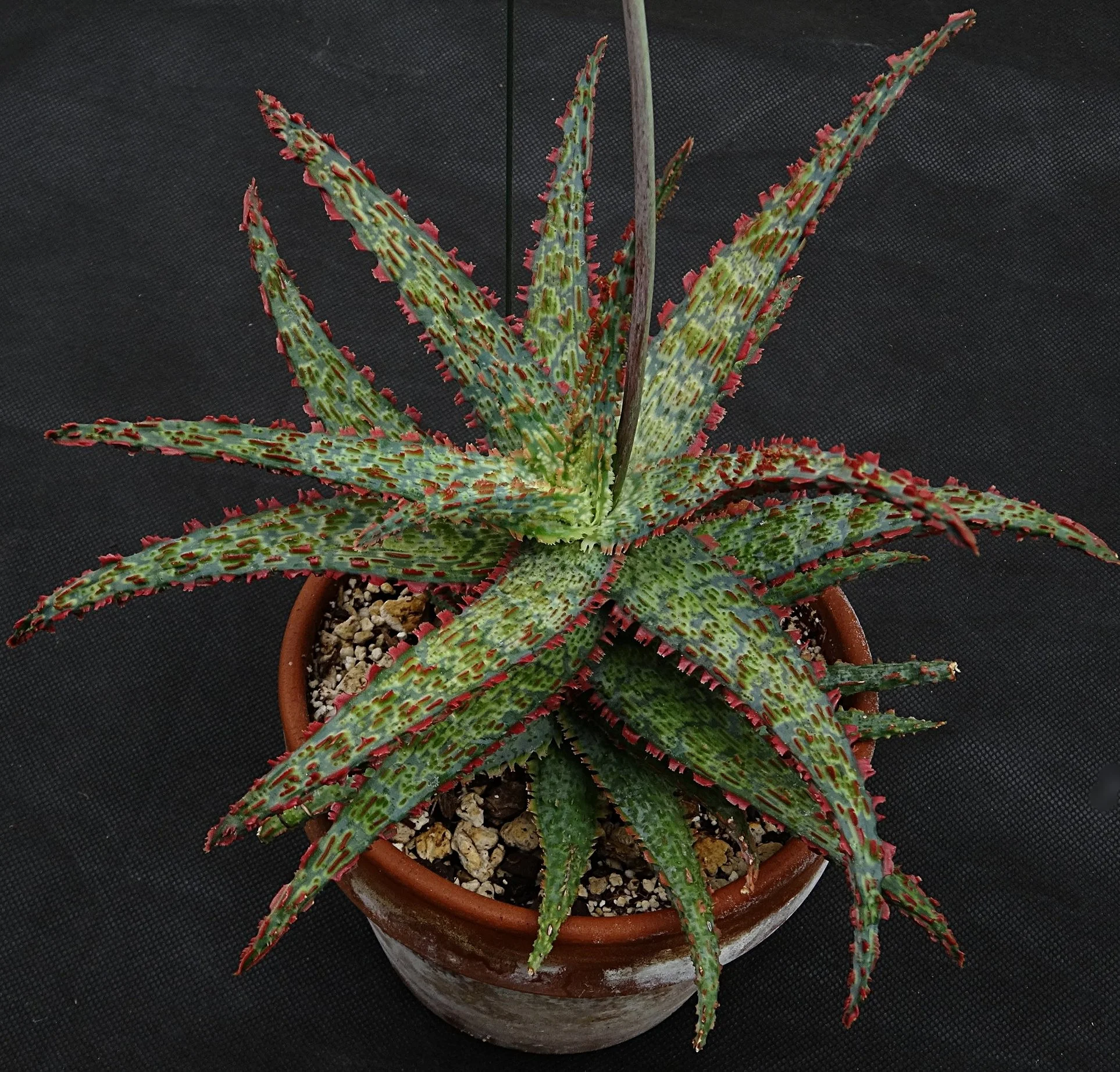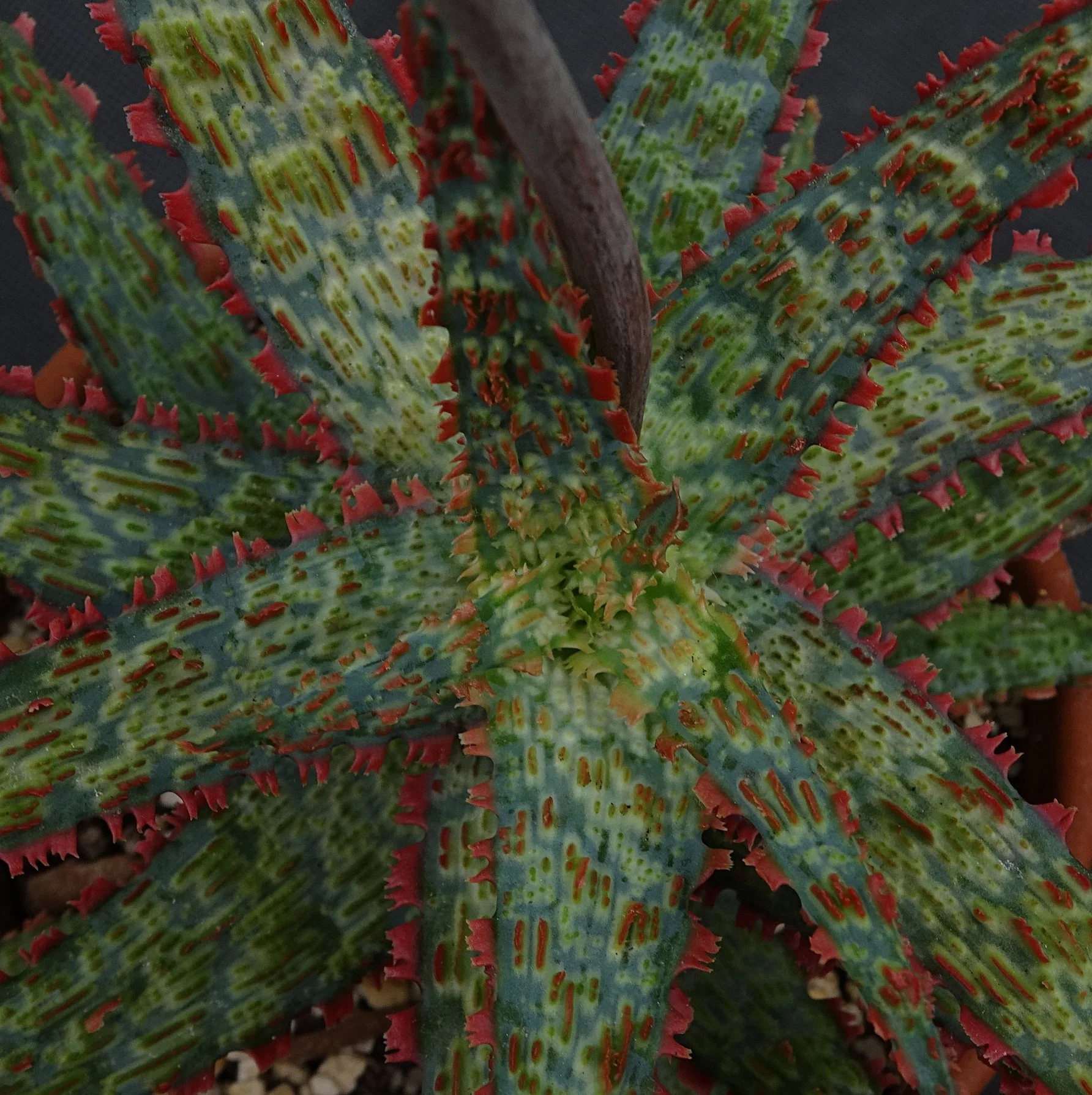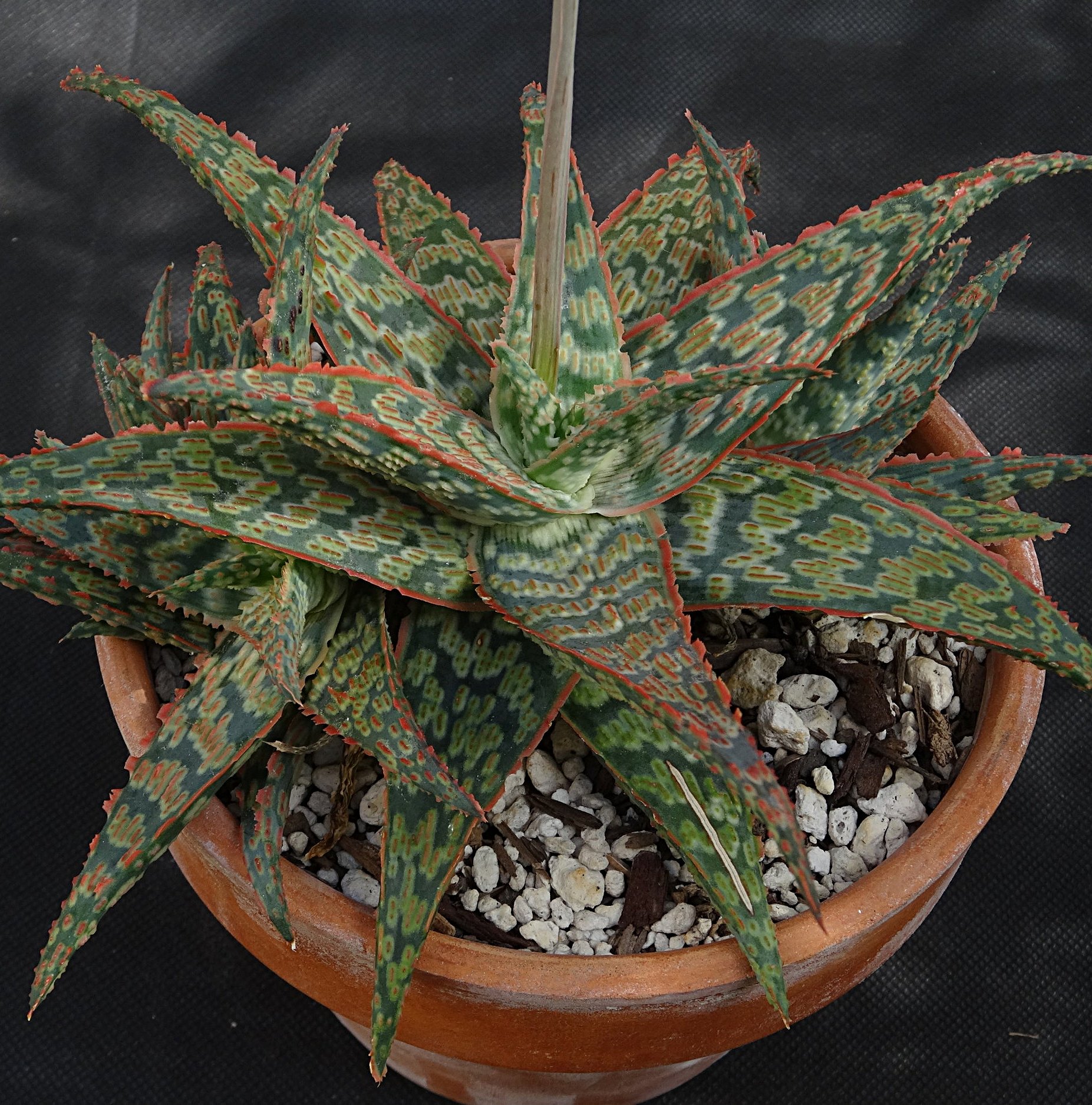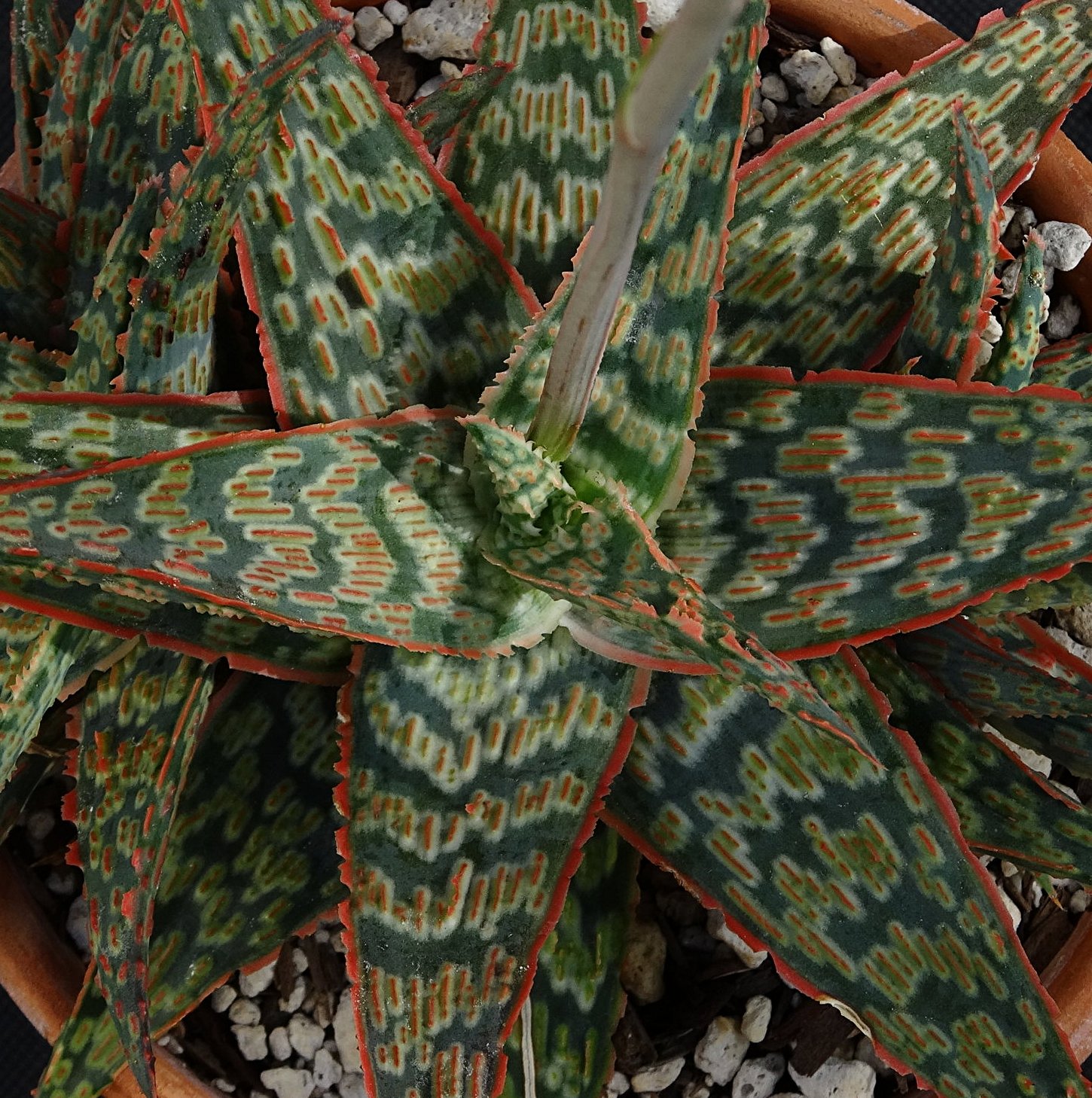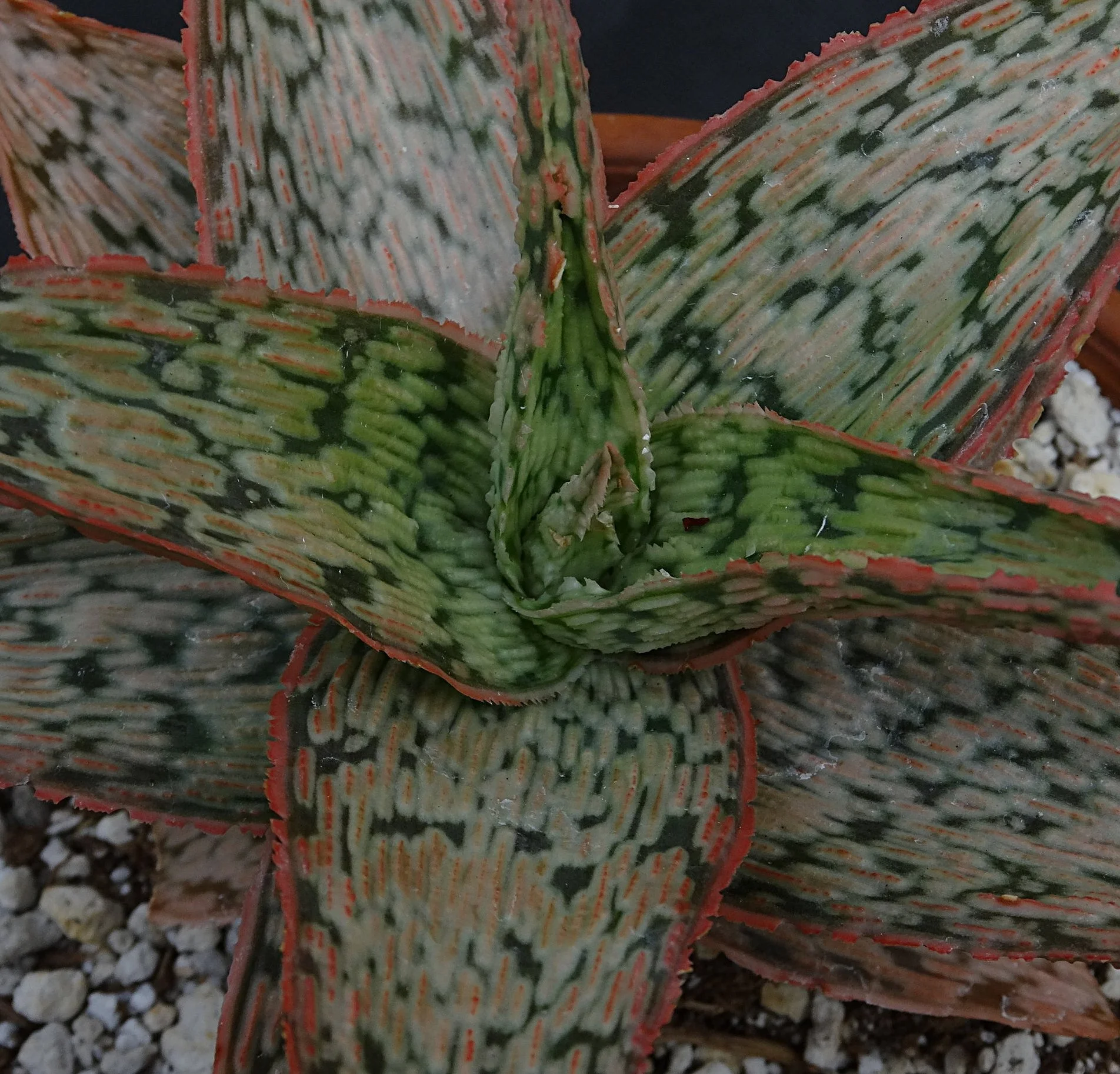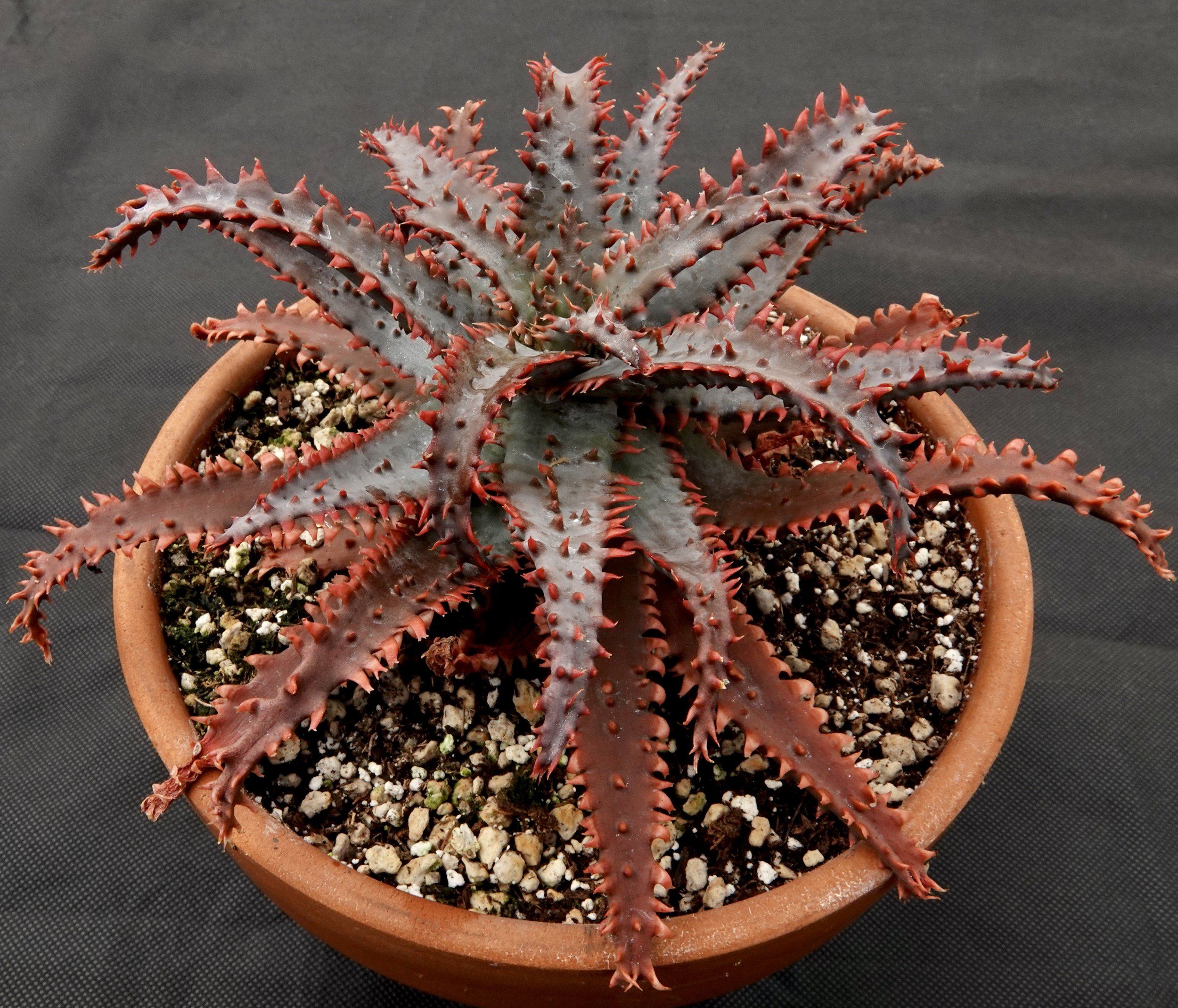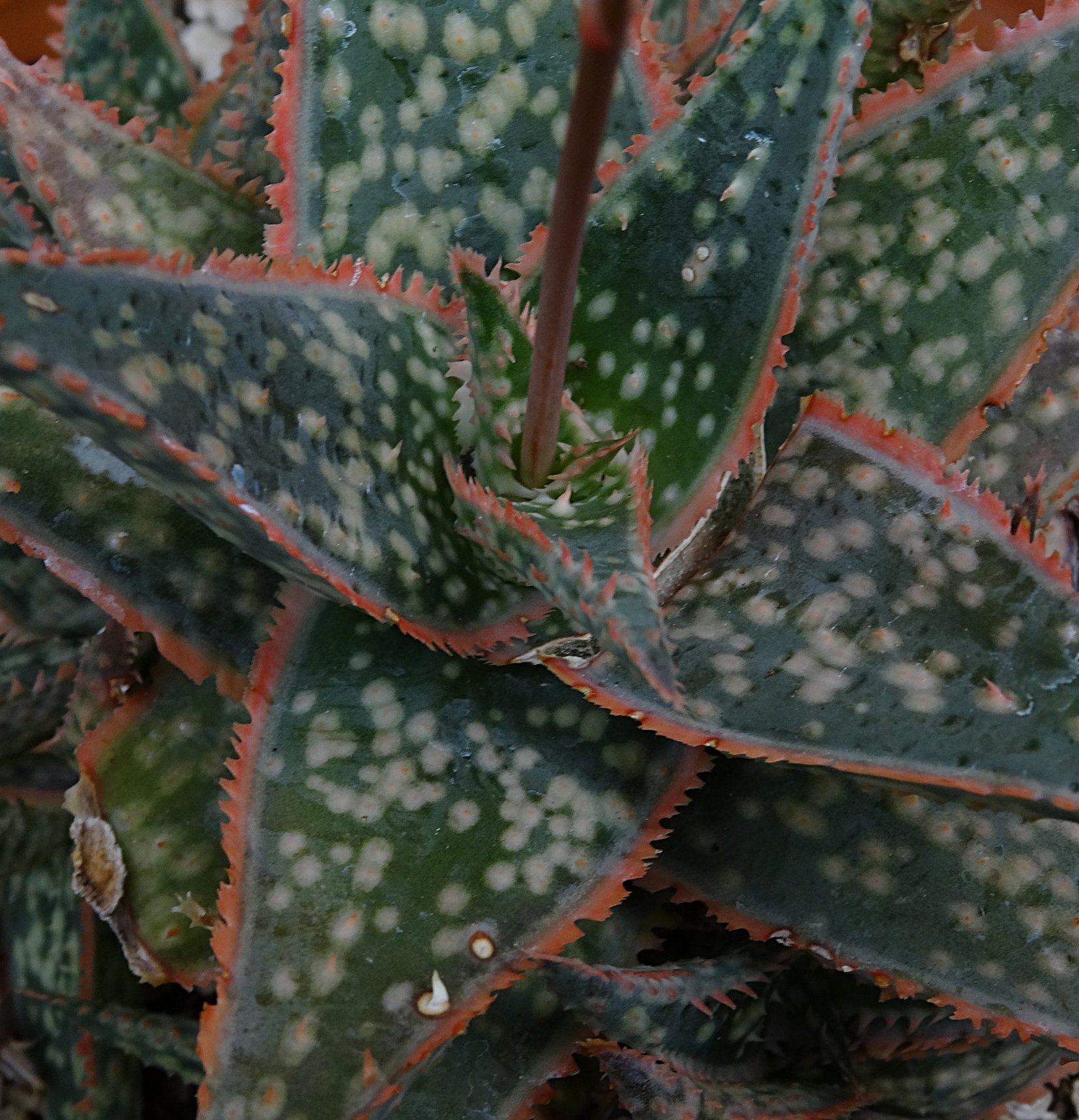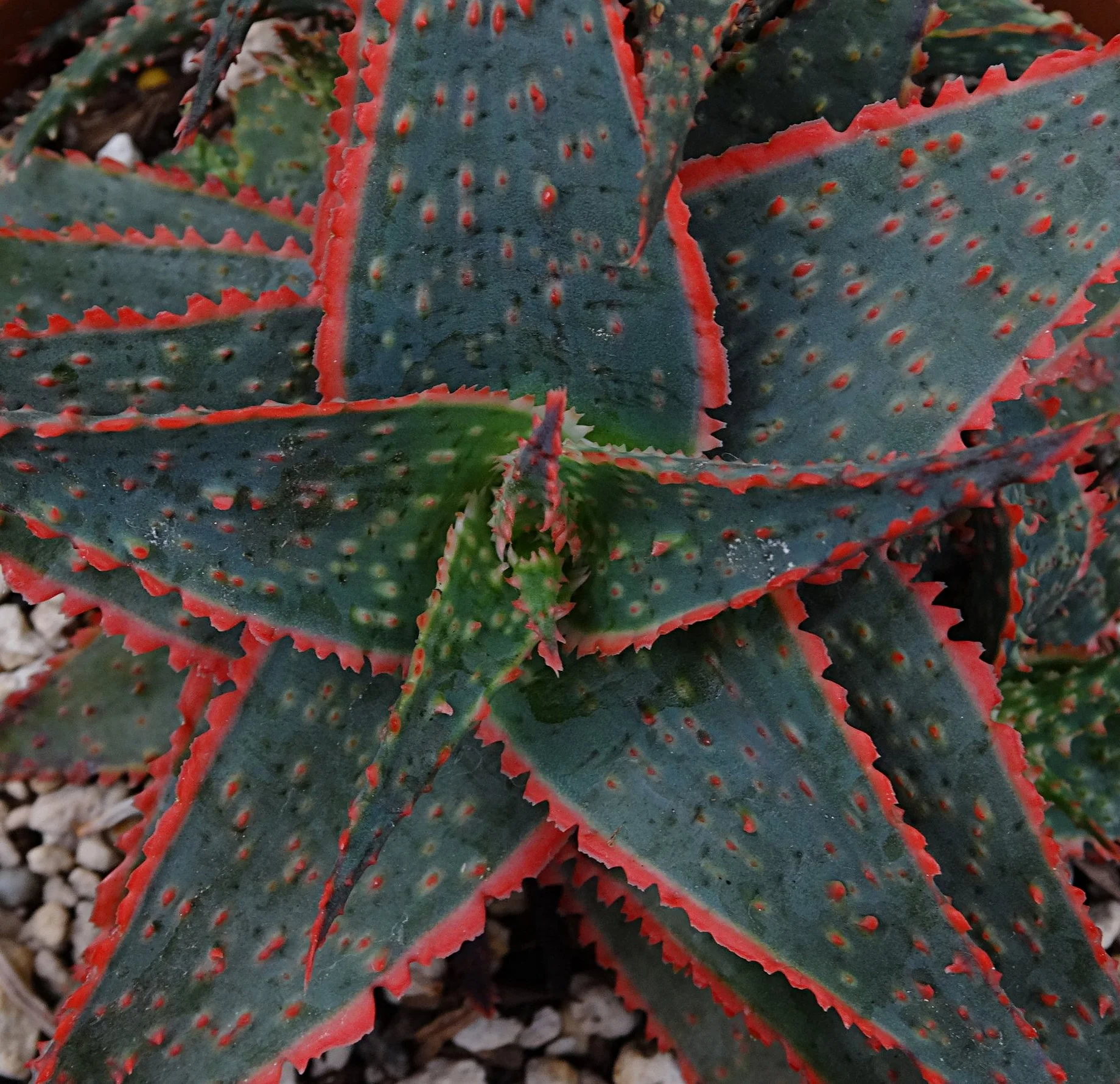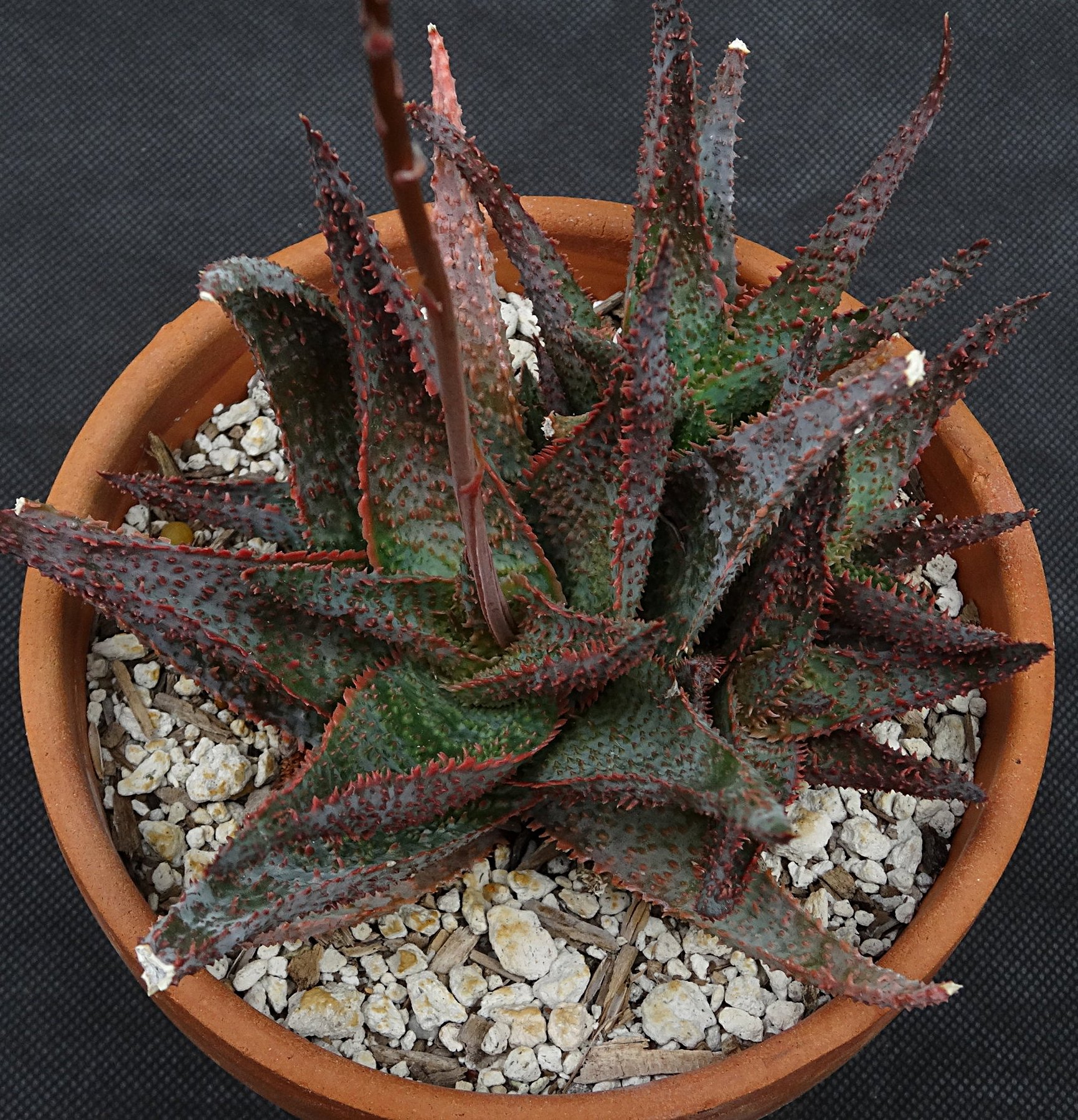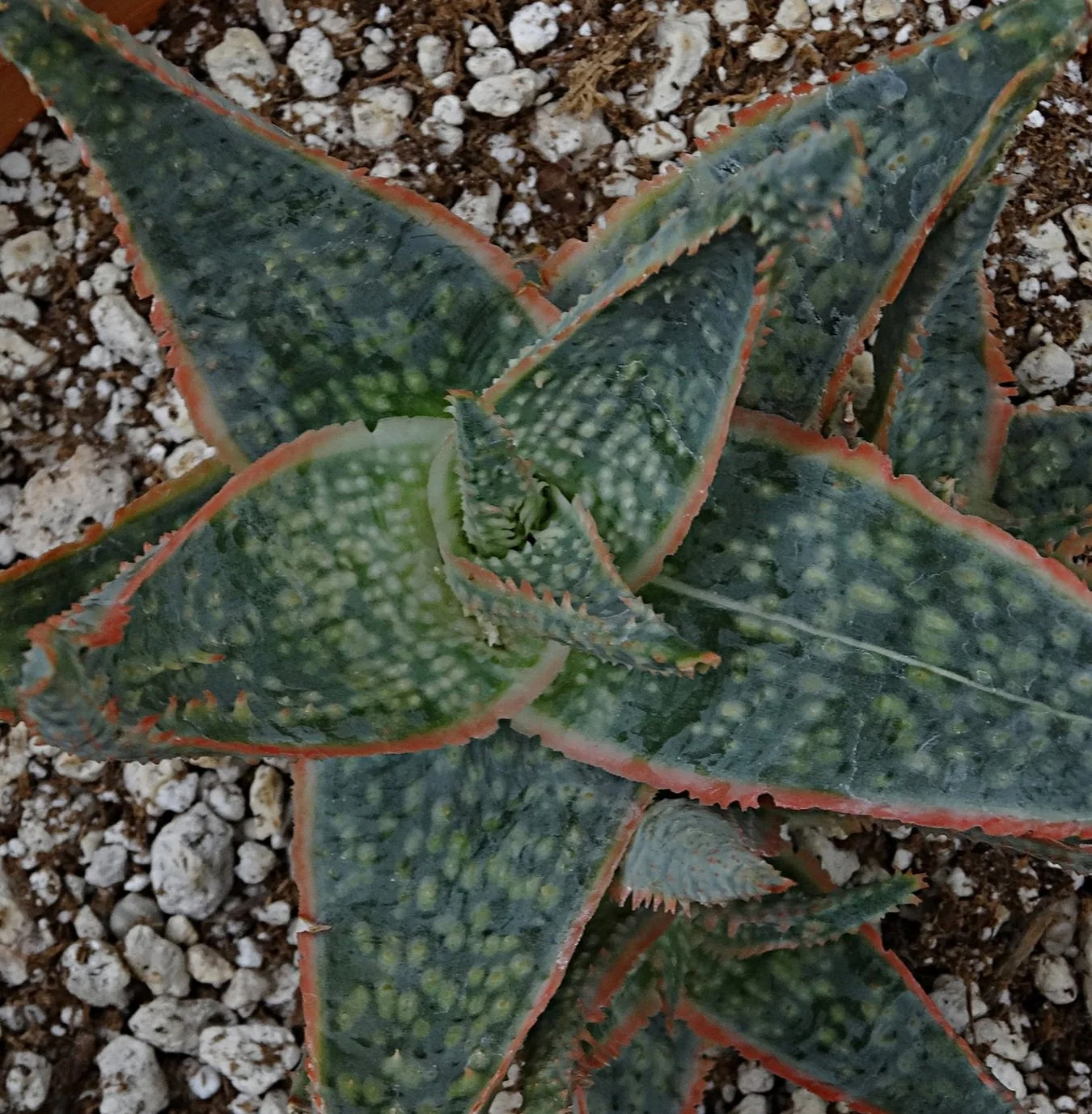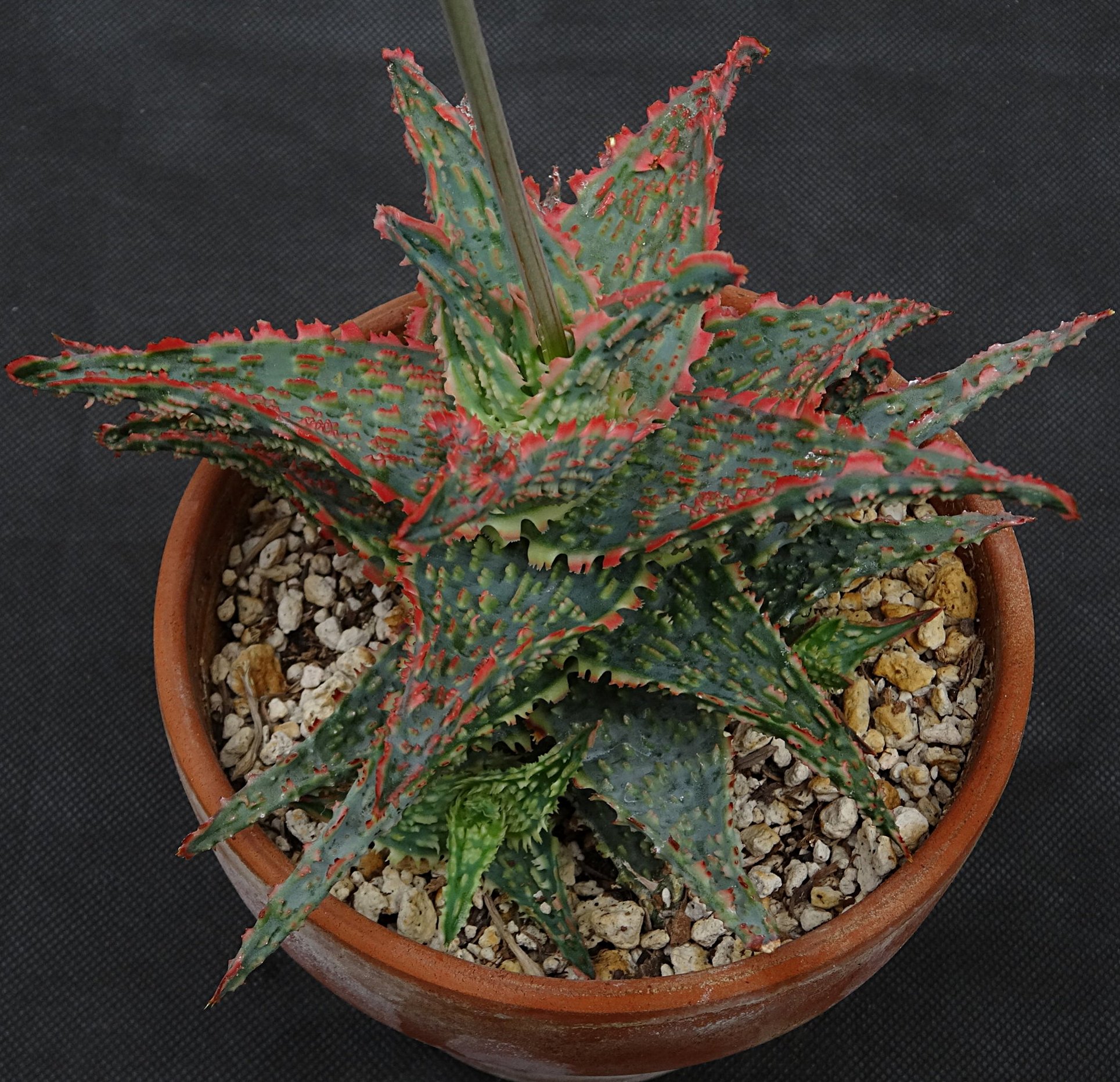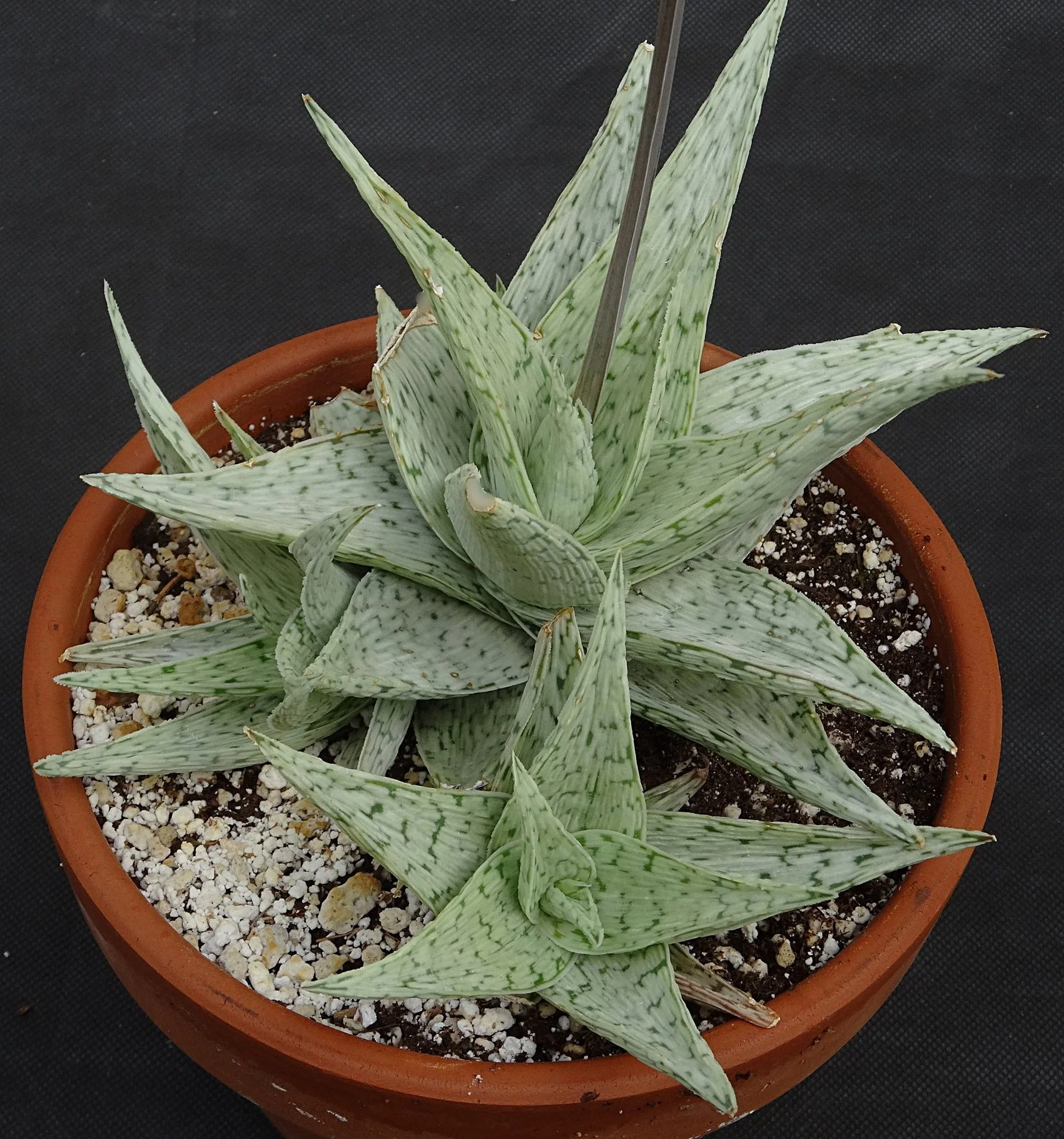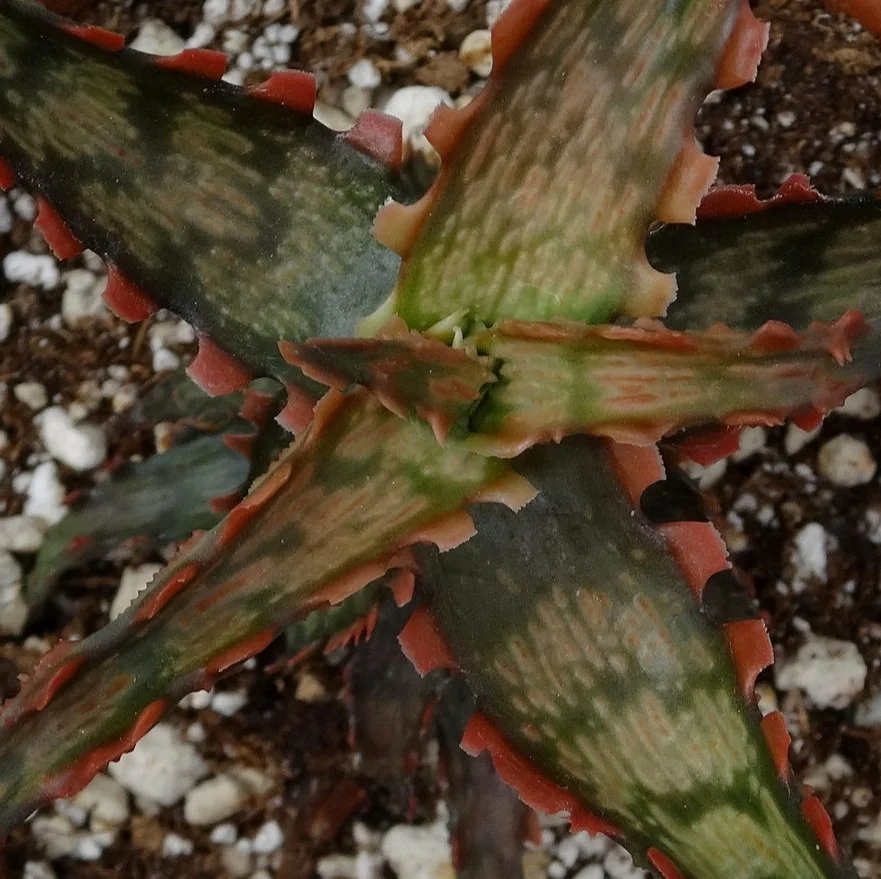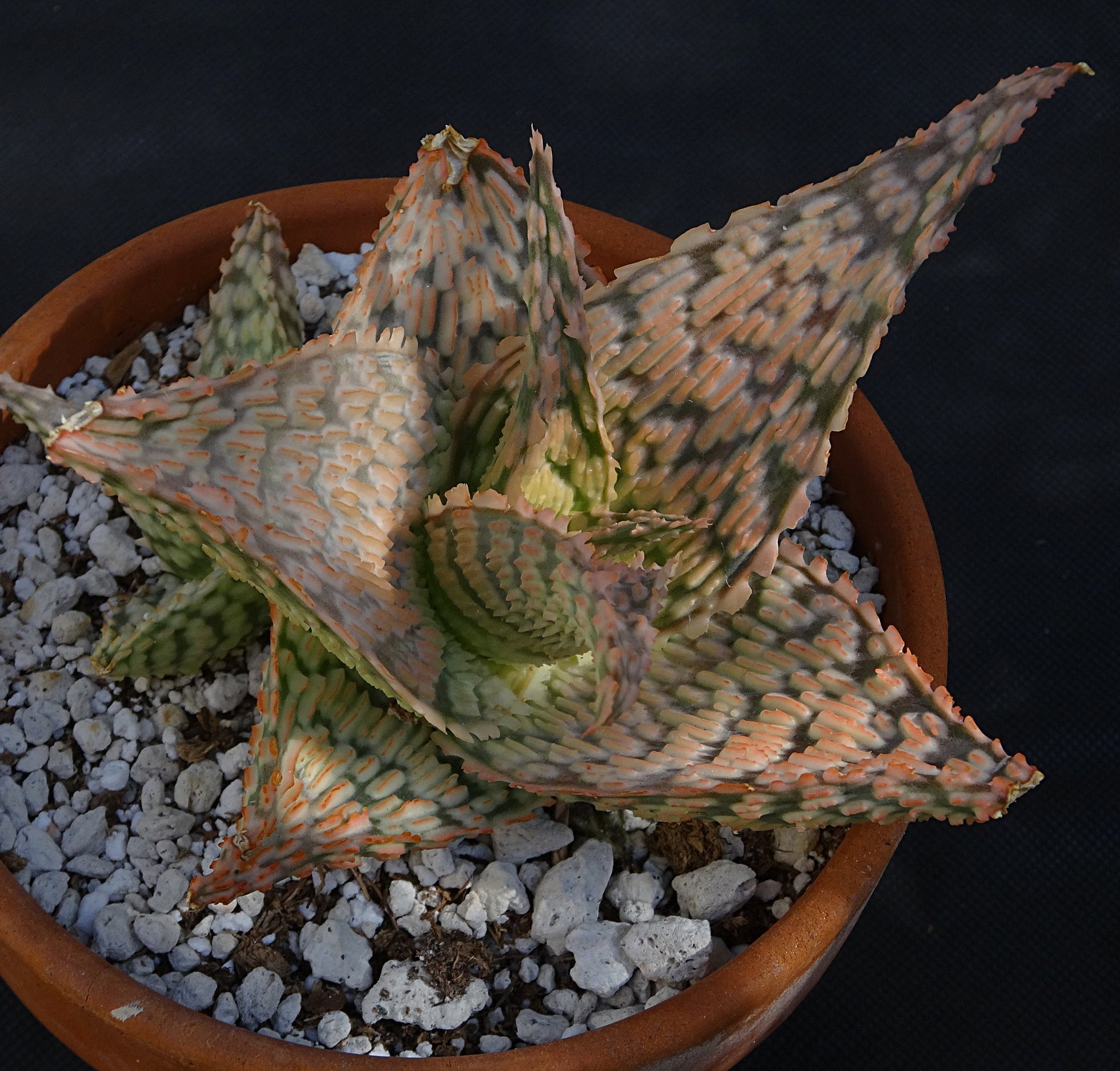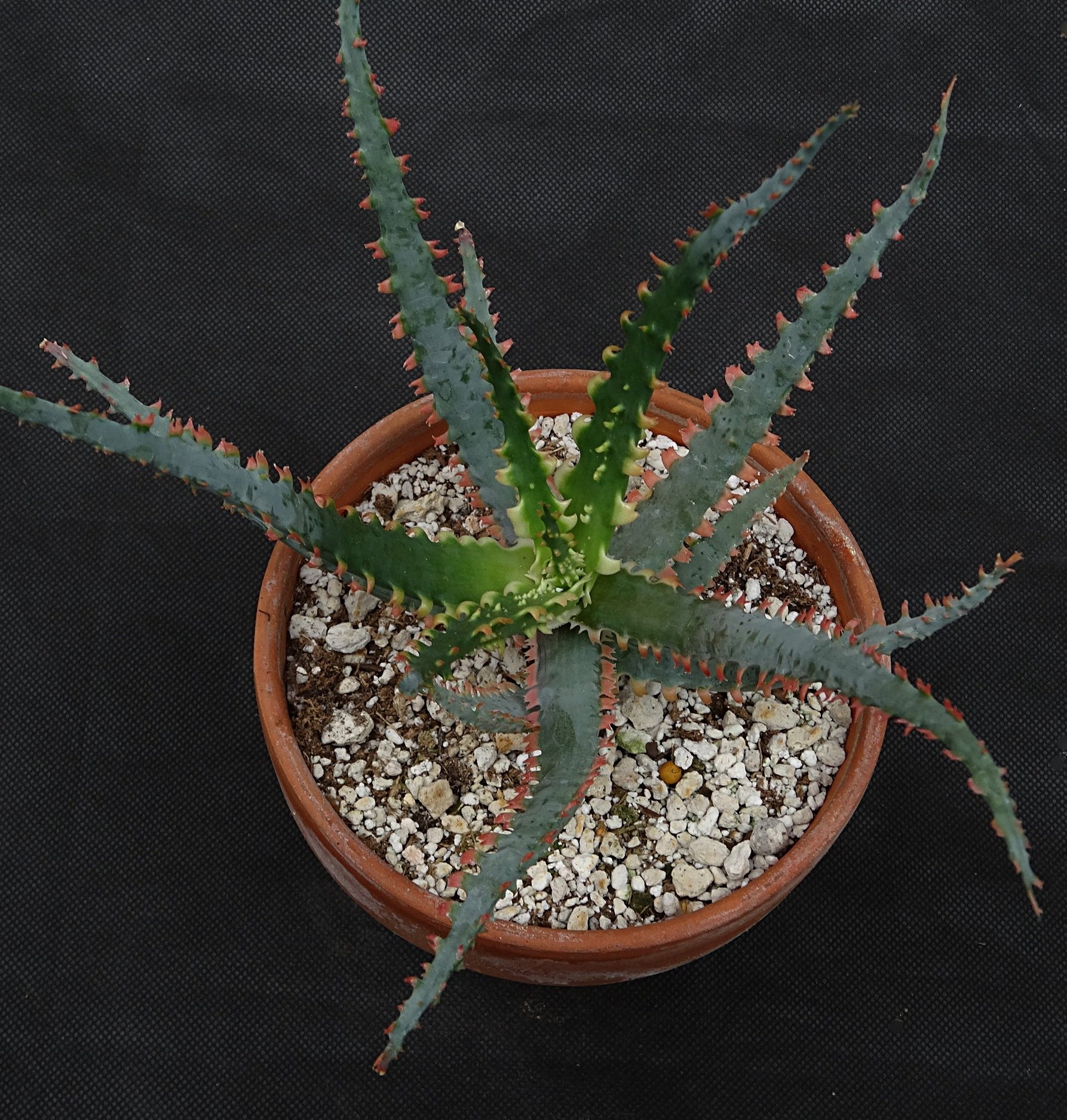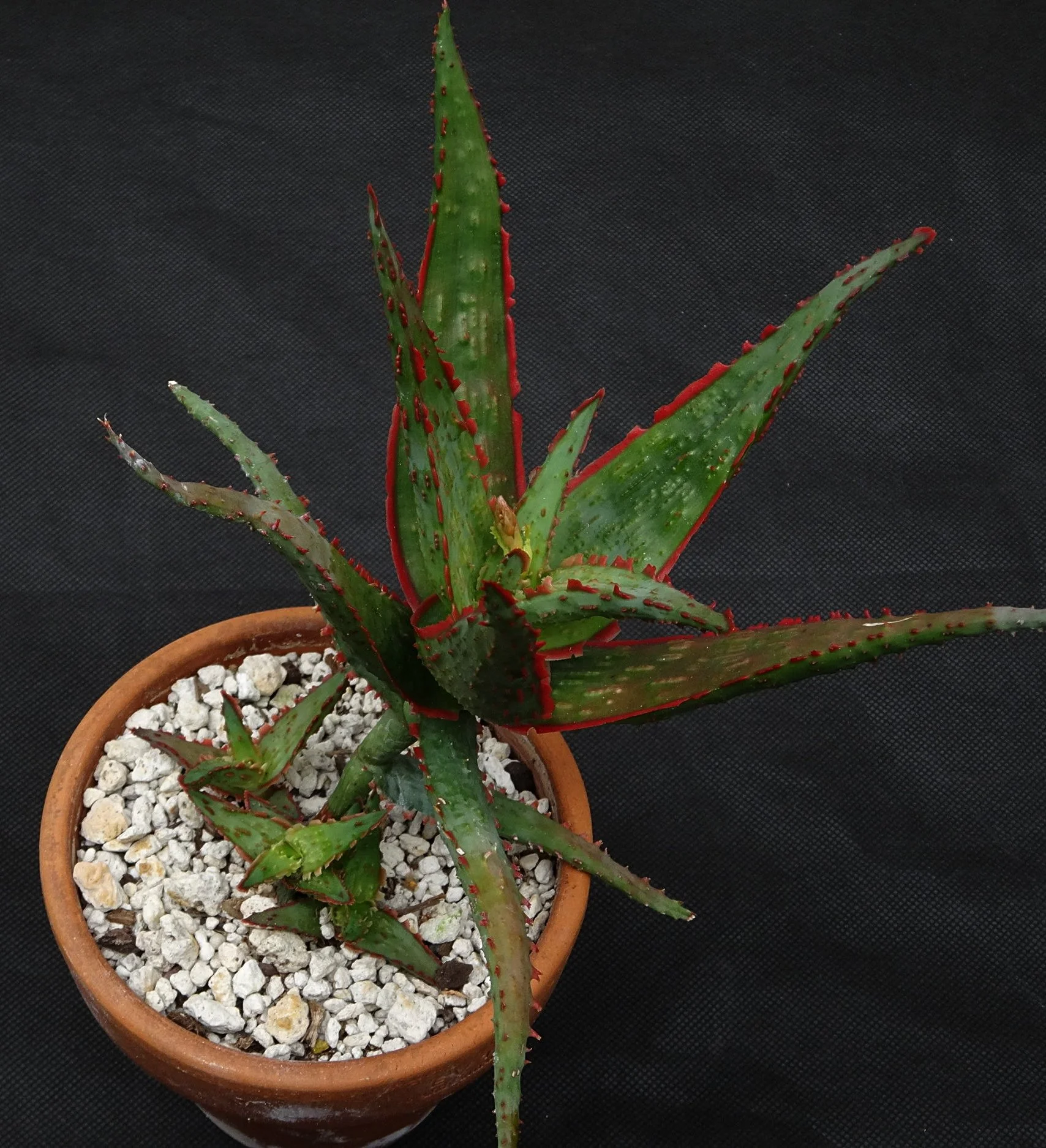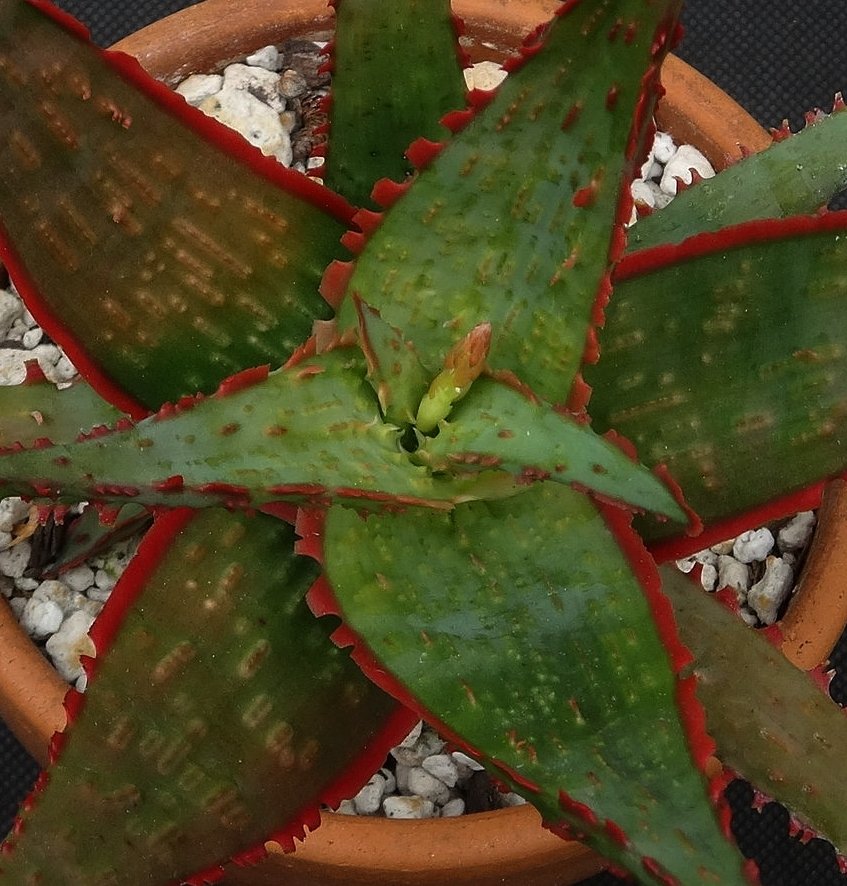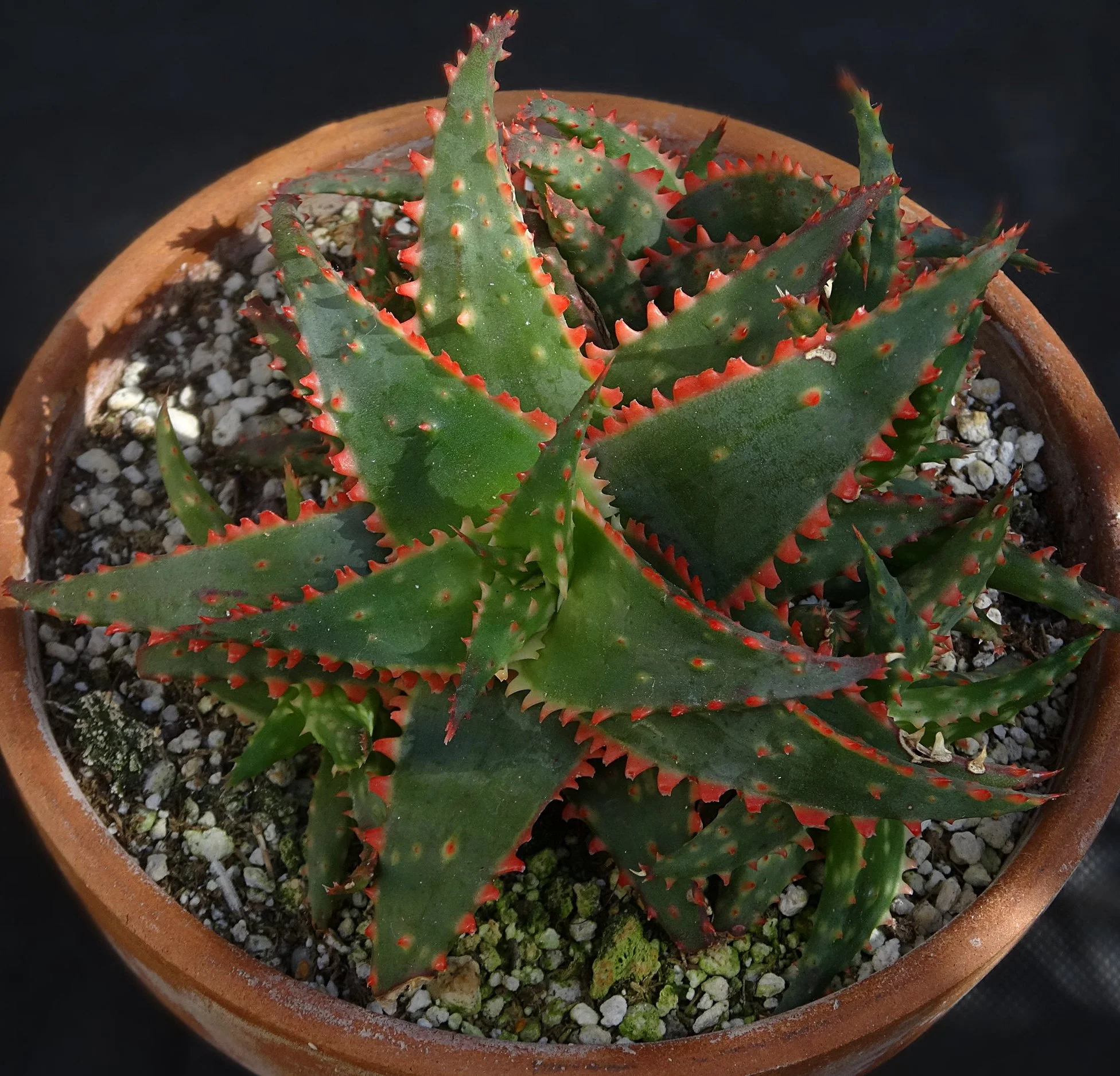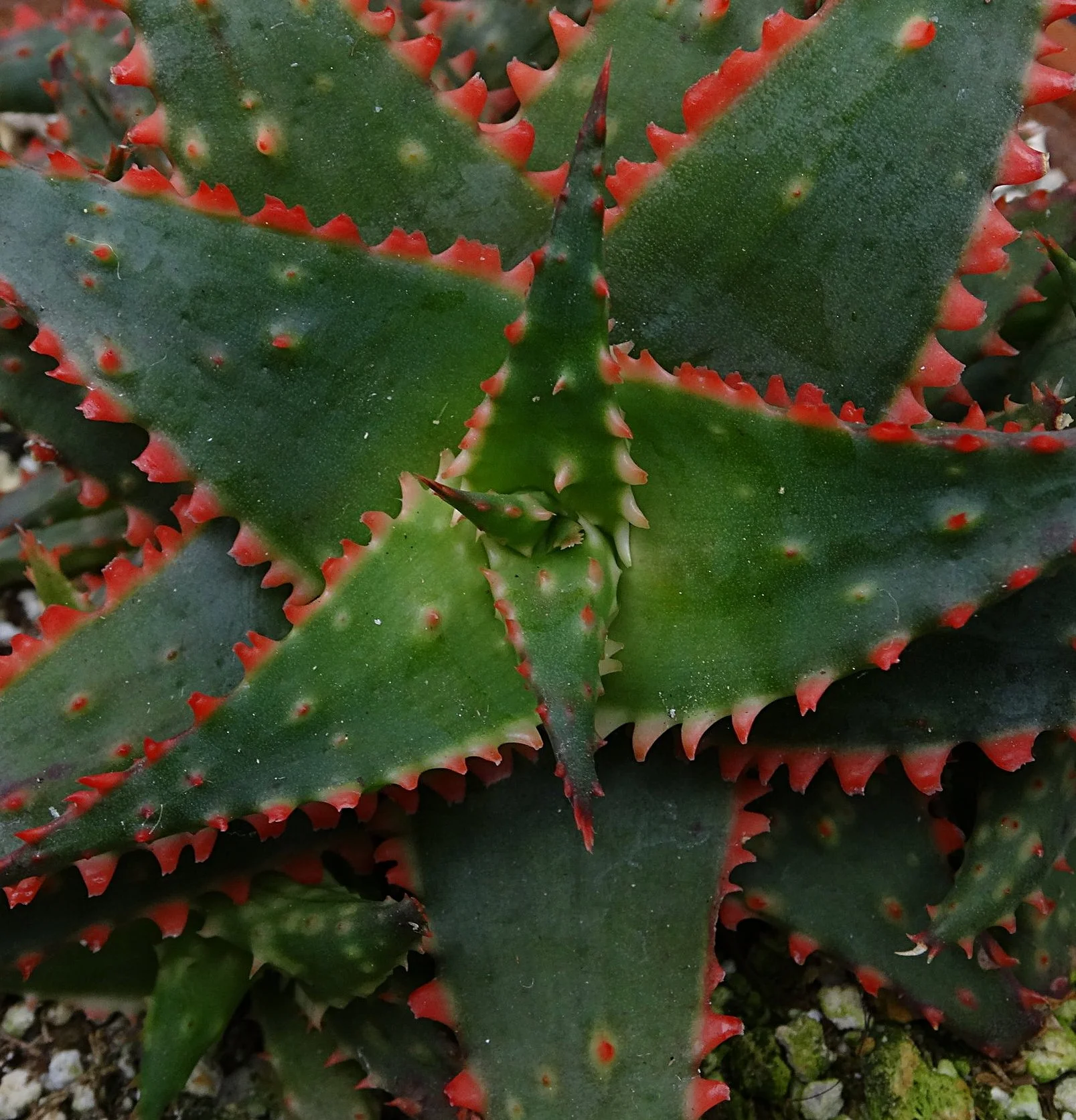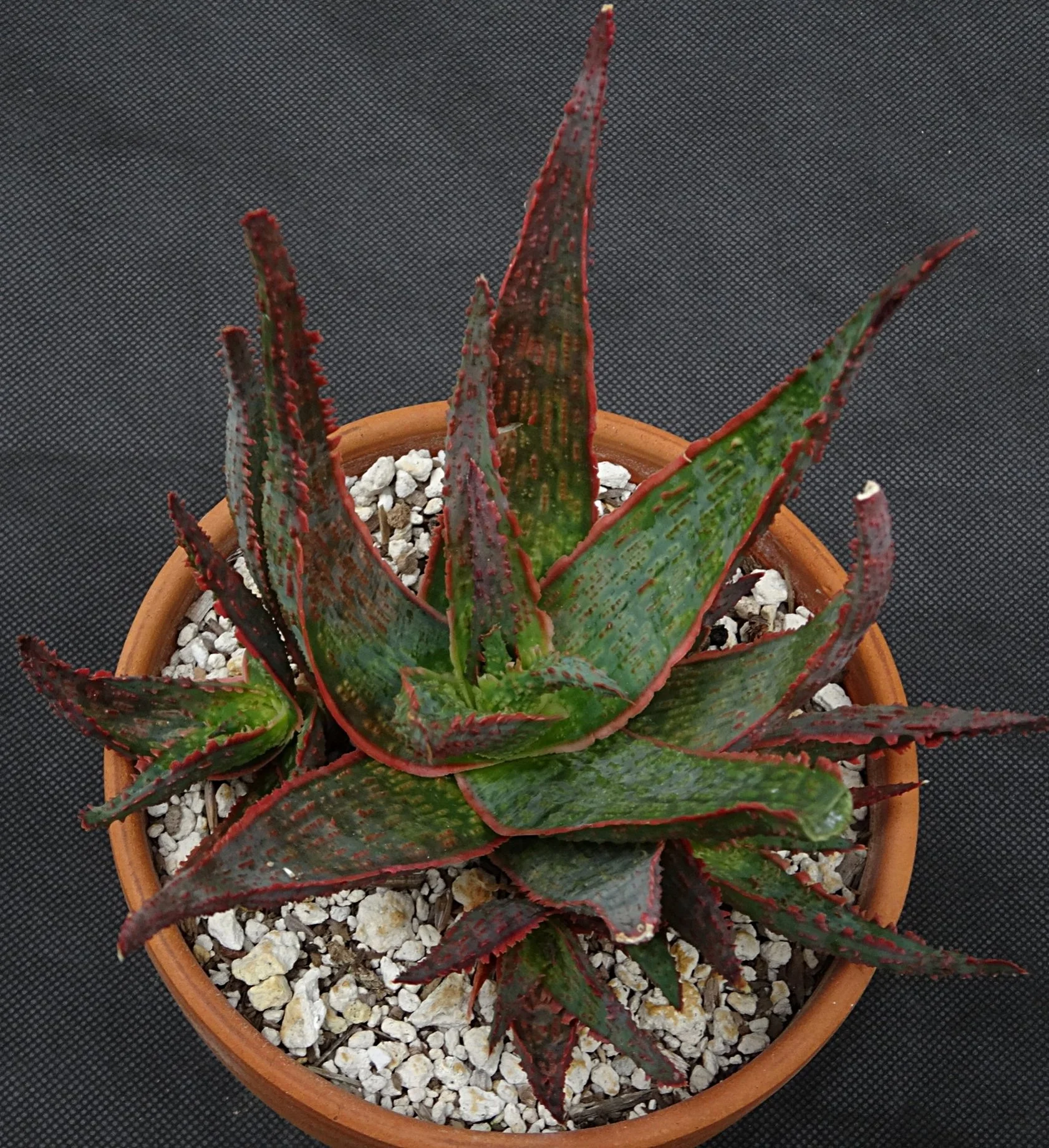A Field Guide to the Fantasy Aloes of North America
by Jay Vannini
Flowering Aloe cv. ‘Wrasse’ (green form).
Dwarf “fantasy aloes”, otherwise known as “tabletop aloes”, “eccentric” dwarf aloes, or “Kelly Griffin-type” aloes are very much in vogue as part of the larger global succulent craze. Most of them are complex hybrids involving a dozen or so Madagascan and South African aloe species crossed, re-crossed, then crossed again (and again!) to result in the current selection of very colorful and extraordinary-looking plants. The multi-generational hybrids that have emerged from contemporary ornamental aloe breeding that show promise in commerce are usually micro-propagated via plant tissue culture (PTC) to produce many hundreds of thousands of lookalikes that are distributed in plug trays and small pots throughout the global nursery trade. A few relative rarities are still propagated exclusively via offsets.
“Tabletop succulent” is a catch-all term to describe non-cactus stem succulents that can be grown to maturity on a side or patio table, under plant lights, or on a sunny windowsill. Many popular genera have species and hybrids that fit this description, especially Sepervivum, Echeveria, Aloe, Haworthia, and Sedum. Other genera better known for their large to giant species and usually associated with dry landscapes, such as Agave, also have tabletop suitable species or sports (e.g., A. parviflora and A. isthmensis).
In practical terms, “tabletop” means that the mature rosettes of these plants are usually in the 2-12”/5-30 cm range and they can normally be grown to full size in a 6”-8”/15-20 cm pot. In my own collection I prefer vented Italian terracotta pots and bowls in varying sizes for permanent plantings but, like all nurseries and most hobbyists, I also use multiple-use plastic nursery pots for seedlings and small plants with great success.
Dwarf aloe breeding appears to have begun on a semi-serious basis with John Bleck’s Aloe ‘Pepe’ (A. descoingsii x A. haworthioides) sometime in the early 1980s, but apparently didn’t begin to gain real traction until the early 2000s. Like many other popular collector succulent groups, fantasy aloe breeding is dominated by a handful of individuals in the western U.S. Best known among them are Kelly Griffin (Rancho Soledad Nurseries, Xeric Growers and Altman Plants) and Karen Zimmerman (the Huntington BG) but Dick Wright (Wright Nursery), John Bleck (private-California), Larry Weisel (Altman’s again), and Nathan Wong (private-Hawaii) have all produced numbers of noteworthy and improved miniature complex hybrids.
Below, left to right, the early and very popular tiny hybrid Aloe ‘Pepe’ with its miniature Madagascan parents, A. descoingsii and A. haworthioides. All three plants have been used extensively in hybridization over the past decades and many purportedly “pure” examples of the two species shown are, in fact, hybrids themselves. Clicking on images will open in a lightbox.
This is a group of succulents that would normally check every box that I use to exclude plants from my collection, particularly the mass-market ones produced in PTC by San Diego County-based Rancho Tissue Technologies and Altman’s. They often have fuzzy genetic backgrounds with unknown or poorly-documented parentage; many selections are readily available at run-of-the-mill garden centers and Big Box stores (or even high-end supermarkets); they attract semi-informed YouTube garden commentators like flies; they loom large in “cute” Etsy and Pinterest presentations, ad nauseum. An added disadvantage is that plants that have passed through the supply chain for any length of time and onto the average commercial nursery bench may have temporarily invisible infestations of aloe gall mite (Aceria aloinis), so ALL new acquisitions require rigorous quarantine and prophylactic sprays of the few several rather expensive miticides that are effective at controlling eriophyid mites.
So, why do I bother with these things? Better yet, how in blazes did I end up with more than three dozen types of them camped on my terrace?
For several years I have grown a very small selection of miniature to compact species aloes and related genera that include several uncommon, very attractive collector plants (e.g. Aloe erinacea, A. castilloniae, A. droseroides, A. inexpectata, Haworthia lanosa, etc.). These dwarf species were, so to speak, the “gateway drug” that seduced me to looking into fantasy aloes. In late 2016 I became aware of some of the more exotic-looking complex hybrids that Karen Zimmerman had made at the Huntington and released as PTC propagates via the International Succulents Introduction (ISI) program there starting in 2010. As is evident below, all of her better-known offerings can most certainly be characterized as extraordinary-looking plants.
After judiciously acquiring a few species over the first six months, I admit that I then rapidly succumbed to the temptation to buy ALL of them over the next year and a half.
Such is the lot of a hard-core plant collector…
Starting with simple crosses (such as ‘Pepe’ and ‘Fiesta’), fantasy aloe breeders have rapidly coaxed ever-more startling and exotic leaf ornamentation - in the form of denticles, ridges and conspicuous marginal teeth - as well as unusual and very vivid colors out of their offerings. These include bold zebra-striping, dark blues, hot pinks, fiery oranges and brilliant reds greatly enhanced from the more subdued native hues of wild aloes. Madagascan/Malagasy species, especially the tiny A. descoingsii shown above, have been used mostly so far with a touch of South and East Africa here and there in the blends. A good example to show the complexity of some of even the older (late 1990s vintage) fantasy aloe hybrids is the John Bleck cultivar ‘Lizard Lips’. This is reportedly an F2 hybrid of four different Malagasy dwarf species, (A. descoignsii x A. calcairophila) x (A. bellatula x A. rauhii) that –depending on growing conditions–is often very similar-looking to its A. rauhii grandparent. This example, like some other lookalike hybrids that come to mind, may beg the question, “What’s the point?”. In this particular case, the coveted RHS “Award of Garden Merit” was bestowed on ‘Lizard Lips’ due to its combined traits of exceptional ease of cultivation, ready availability, showy appearance and compact size.
Aloe pseudoparvula flowering on my terrace in early July 2017.
Aside from A. descoingsii other standout parents and grandparents of many modern hybrids include: A. divaricata, A. parvula, A. bakeri, A. deltoideodonta, A. rauhii, A. haworthioides, A. albiflora, A. juvenna, and A. bellatula. More recently, breeders and hobbyists (including me) have been able to add the genes of very attractive, relatively new species in cultivation such as A. pseudoparvula (published in 2004) and A. castilloniae (published in 2006) to the mix. An examination of the species mentioned previously will often reveal a strong resemblance to complex hybrids as has been noted in the previous paragraph, but also see A. bakeri superficial similarity to things like young A. ‘Gargoyle’ (= ‘KG #5 x ‘Aumakua Mano’). These “hints” may be useful to breeders in unraveling the often-mysterious origins of F3+ hybrids whose parentage has been lost or intentionally obfuscated. It should come as no surprise that commercial breeders are often cagey about sharing their hybridization strategies.
A few well-known introductions made since 2015 are, in my opinion, so exceptional that random crosses made between almost any of them, or back to A. descoignsii or A. ‘Pepe’ will probably produce at least a small number of desirable miniature progeny for a hobbyist from each seed sow. Indeed, some of the very recent online offerings by commercial breeders in Thailand that are ostensibly based on noteworthy recent Griffin or Zimmerman hybrids show a great deal of promise. On the flip side, there are some private growers and nurseries around the world who will list any junky, unremarkable, randomly-pollinated complex hybrid as a “Kelly Griffin type” or “Karen Zimmerman variety”, free-riding on these hybridizers’ reputations as a sales pitch. New, desirable cultivars now appear on the market with some degree of frequency, particularly from Kelly Griffin’s/Altman’s introductions from PTC.
Care should be taken when purchasing any of these hybrids from sources other than very reputable nurseries. Besides the very real risk posed by accidental introductions of aloe gall mites to collections, unscrupulous eBay and Etsy sellers routinely enhance the colors of their images to generate interest and social media buzz. While all of these hybrids will vary in color and form to some degree based on cultural conditions, collectors should approach purchases of plants based on suspiciously vivid colors in digital images shown online with caution. There is also apparent genetic drift in some hybrids being propagated in PTC that may manifest itself with more subtle color and/or spine variations and the odd variegate or three. Note that changes from very bright, warm and dry growing conditions to cool and shade will subdue previously vibrant colors in very short order.
Unopened flower buds on an Aloe cv. ‘DZ’ inflorescence showing typical pale corolla tips. Late summer and fall are peak flowering times for fantasy aloes in this area.
Also be aware that Aloe is a CITES-listed genus (Appendices I and II), including hybrids but excluding A. vera. There are well-telegraphed legal restrictions to moving them across international boundaries without export permits from the proper authority. Caveat emptor to those who purchase undocumented aloes, particularly Appendix I species, online from Thailand and the EU. One of these days you may receive the dreaded “knock on the door” that–I guarantee you–will ruin your day.
Aloes generally have colorful and striking inflorescences. Fantasy aloes are no exception, and many have very showy tubular flowers as an added attraction to their strikingly-marked foliage. Most have typical dwarf Malagasy aloe flower color, with their elongated corollas displaying shades ranging from pale pink through to deep red for most of their length, usually with pale green or cream-colored tepal tips. Most hybrids in this group produce flowers that are coral pink with light green and white striping. They will usually start flowering in the late spring with peak flowering in the San Francisco Bay Area during late summer and early fall. Vigorous, established plants will flower twice or more yearly and can put on quite a show in late summer. Inflorescences will often branch early in mature plants, and keikis/plantlets may occasionally form on basal bracts of the inflorescences. These can be removed and propagated on when the inflorescence is finally pruned off.
A three week-old compot of hybrid aloe seedlings, sown during the first week of September 2018.
Pod maturity from hand pollination during spring and summer at intermediate to warm daytime temperatures and cool nights in this area ranges from 32 to 85 days. Most hybrid pods from my own crosses starting to split somewhere right around 50-55 days following pollination date. Successfully-pollinated flowers rapidly show evidence that they “took”, with the ovary swelling visibly after a few days and the pedicel persisting at a narrow, upright angle to the peduncle. Hybrids using A. descoingsii and A. ‘Pepe’ as a seed parent can ripen particularly quickly, so keep a close eye on these for signs of pods splitting after anything past 30 days after pollination. Germination from freshly-harvested fully ripe seed is almost immediate in my experience, with cotyledons/seed leaves visible 7-14 days after planting if correctly surface sown and lightly-covered with coarse sand or fine pumice. I sterilize seedling substrates with boiling water prior to sowing seeds. I do not sterilize fresh seed from my own crosses but would from outside sources with a 10% chlorox solution for ~15 minutes. Properly stored seed should retain viability for more than a year, but germination times may be slower than that seen in very fresh seed. Hybrid plantlets can grow surprisingly quickly for a tropical stem succulent, even under outdoors cultivation in a Mediterranean climate. This rapid growth is a boon to hybridizers since relative vigor, basic color scheme and interesting leaf traits are often evident at a very early age (150-180 days) in these types of aloes, permitting early selection for both “set asides” and discards (see below). My first opportunistic complex cross was made using two fairly good parents produced unremarkable-looking but near-finished small plants in 4”/10 cm pots at less than nine months from seed sow, several of which were already offsetting by that point. Contrast this with the time required to flower many orchids – routinely up to six years plus from seed sowing under optimal conditions to see whether the cross or selfing was worthwhile!
First selection from compot shown above right, eight months from seed sow and ~3”/8 cm across. Note that this plantlet already exhibits elongated tubercles on both leaf surfaces. As expected, two eccentric, colorful and toothy parents produced some bizarre-looking infants.
One common denominator among almost all the most striking dwarf hybrids is their intolerance of severe cold or prolonged spells of very wet, cool weather that is hardwired into many of the dwarf Malagasy species. While there are some notable exceptions that can handle 28 degrees F/-2 C if kept on the dry side, many of the more tropical species will be damaged or killed outright by even brief temperature drops into the low-30s F/0-1 C fro prolonged periods. One great advantage of their small size is that these plants can be brought indoors and spelled (keep on the dry side) near a bright window for a couple months with no lasting damage to their rosette form or color.
Because I water heavily from mid-spring to mid-fall, I use a very free-draining mix composed of 60-70% horticultural grade pumice and 30-40% high-quality composted garden soils by volume depending on the species or hybrid background. To this, I incorporate small amounts on encapsulated gypsum and dolomitic limestone to compensate for our nearly mineral-free tap water and add generous amounts of Nutricote 14-14-14 x 180-day release fertilizer. During periods of rapid growth, I also provide occasional supplemental drenches with MaxSea All Purpose and Cal-Mag Plus at labeled rates.
Aloe cv. ‘DZ’ showing good rosette structure and basal leaf retention at several years of age.
Properly cultivated fantasy and species aloes should retain a full rosette of healthy leaves and normally shed basal leaves at a notably slower pace than they add new ones. I have noticed that some growers show these plants with bare stems even when fairly young, indicating cultural deficiencies past or ongoing. I have received the occasional fantasy aloe grown from stem cuttings that had lost their lower foliage during the rooting phase. I find that they will invariably offset freely at their bases when conditions improved. The leggy top growth can then be pruned off and restarted as a rosette in another pot. Almost all of these selections cluster early in their lives if well grown. Offsets can be removed either by gently prying them from the base of the mother plant, or by freeing them from the main stem with the tip of a sharp knife. Rooting hormones seem to improve speed with which unrooted offsets strike.
Aloe cv. ‘Dracula’s Blood’ offsetting vigorously on a cutting-grown young plant.
These plants are somewhat susceptible to root loss if kept too wet. While (fortunately) a very rare occurrence in my collection, I prefer to treat the rosette as a group of unrooted offsets rather than trying to save the whole plant, i.e. I clip the root ball all the way back to clean stem tissue. Several commonly available garden fungicides, especially Banrot (etridiazole + thiophanate-methyl) are useful to have at hand when growing collections these plants.
Always use common sense and best practices as well as follow local laws when employing any agricultural chemical in your home or garden.
It is Gospel among succulent growers that most Aloe species and hybrids are self-infertile, but selfings can be successful on occasion. I have a very beautiful bright yellow-flowered form of A. humilis from the Huntington Botanical Gardens that is autogamous and regularly sets fertile seed without any manipulation. Plants grown on from uncontrolled open-pollination, often by hummingbirds or bees, can sometimes be attractive and may be marketed as named hybrids on eBay and elsewhere. The bottom line is that if you like the plant but have real questions about the cultivar name, by all means purchase it if you feel the price is right but don’t count on it having a “real” pedigree.
For people interested in learning more about these plants, take note that the internet is unfortunately awash with images of fantasy aloes with the wrong, invented and/or misspelled names attached. As a good faith effort, here is a stab at sorting out the chaos. In almost all of the cases shown below, my plants have been purchased from the original source nurseries or three very well-known and respected U.S. commercial sources for collectors’ succulents: Corona Cactus, Arid Lands Greenhouses and Out of Africa Plants, as well as the Huntington Botanical Gardens. That said, even the very best nurseries can mislabel/lose track of their plants.
Here goes with a guide to some of the best hybrids available in the trade so far. Rather than relying overmuch on leaf colors, which can vary enormously within clones depending on cultural conditions, I find that overall growth habit, marginal teeth arrangements and denticle patterns on the upper leaf surfaces are very useful diagnostic features. Buyers and growers should be aware that fantasy aloes grown “soft” under excessive shade can lose their contrast colors entirely (see A. cv. ‘Sunrise’ images below for a good example of this).
The photos included here were all taken on overcast mornings over a three day period to minimize glare, shadows and to bring out base color contrasts. No flash was used. Other than cropping and sharpening up a few details for illustrative purposes, images here are not retouched to enhance native colors and can be checked against terracotta pot shades. Cool nights, warm days and full exposure to morning and midday sun, coupled with proper nutrition, definitely help to bring out high color in these plants. Note that most of plants shown have freshly-emerged inflorescences visible, which is typical for early fall in this area. Since the leaves of some of these aloes are very faintly translucent, rosettes that are strongly backlit by late afternoon sunshine can seem to glow when seen at close range.
And for the still incredulous, I can assure you that Karen Zimmerman’s Aloe cv. ‘Oik’, A. cv. ‘Marsha Layhew’ and A. cv. ‘Secret Agent’ creations really do have these improbable color combinations when they are grown fairly “hard” in coastal central California.
Several excellent hybrids are missing from the gallery below, the most notable being Aloe cv. ‘Brown Betty’ and A. cv. ‘Jeff Karsner’. Both are Karen Zimmerman hybrids released via the ISI from 2010 to 2016. The first cultivar on this list is easy to find for sale in online cactus and succulent nurseries, while the other is still occasionally available from ecommerce sellers. In my opinion, A. cv. ‘Jeff Karsner’ (2014) is definitely worth having around.
Clicking on individual images below will open them in a lightbox. Identities and comments are shown below each pair of photos. Breeders’ names are shown in parentheses when known; KZ = Karen Zimmerman and KG = Kelly Griffin.
All images ©Jay Vannini 2018-2024.
Aloe cv. ‘Secret Agent’ an ISI 2018 release of a novelty Karen Zimmerman hybrid, perhaps one of the finest miniature ornamental hybrid succulents on the market today.
Aloe cv. ‘Blizzard’ (Altman’s).
Aloe cv. ‘Coral Fire’ (KG).
Aloe cv. ‘Piranha’ (Larry Weisel).
Aloe cv. ‘Orange Marmalade’ (KG). Notice subtle changes in leaf color depending on individual rosette’s orientation and exposure to direct sunshine. This plant was shade grown and entirely gray-green with no contrast colors when purchased 18 months ago.
Aloe cv. ‘Viper’ (KG). Grown very “hard” here; healthy with high color and offsetting but probably prefers slightly more shaded conditions and a tad more water to look its best.
Aloe cv. ‘DZ’ (KZ). A justifiably popular 2010 ISI introduction that is now nearly ubiquitous in the trade, but - ten years on - is still one of the very best fantasy aloes that is readily available to U.S. collectors.
Aloe cv. ‘Marsha Layhew’ (KZ). An outstanding 2014 ISI introduction that continues to “wow” people who see a large one.
Aloe cv. ‘Wrasse’ (Larry Weisel). There is some drift evident in this PTC-propagated clone, with some individuals tending towards deep red tones dominating greens under identical growing conditions. This is the green form.
Aloe cv. ‘Pink Blush’ (KG). An older KG hybrid.
Aloe cv. ‘Wily Coyotee’ (KZ). A 2016 ISI introduction that remains one of the most desirable recent compact aloe hybrids. This clone exhibits considerable color variation depending on light and watering, but is always stunning when well grown. Surprisingly rare in the trade despite plant tissue culture origins of the ISI releases, likely due to its rather stingy offsetting.
Aloe cv. ‘Bright Star’ (KG).
Aloe cv. ‘Christmas Carol’ (KG). Probably the most widely propagated and sold of all the fantasy aloes. A very showy compact hybrid that is underappreciated by many succulent collectors due it being a “common” plant.
Aloe cv. ‘Lavender Star’ (KG). This cultivar generally looks somewhat better with less direct sunlight and pampered a bit.
Aloe cv. ‘Icicle’ (KG). Some nice leaf ornamentation on this cultivar that becomes more exaggerated as size increases. This plant’s color will vary enormously depending on light intensity and watering frequency. Apparently, there may be two sibling clones trading under this single cultivar name.
Aloe cv. ‘Raspberry Ruffles’ (KG). Very variable depending on growing conditions.
Aloe cv. ‘Oik’ (KZ). A 2013 ISI introduction. See comments for cv. ‘DZ’. More compact rosettes than cv. ‘DZ’ that offset more freely. Leaf color can also be very variable depending on conditions in cultivation, but show a strong tendency towards blue background colors on the lamina, particularly when grown cool and dry.
Aloe cv. ‘Quicksilver’ aka (?) ‘White Stag’. Breeder unknown and older introduction. Personally, I am not a fan of this type of fantasy aloe, but this is a good example of the very pale forms that are popular with nurseries.
Aloe cv. ‘Silver Star’ aka ‘Guido’ (KG).
Aloe cv. ‘Gargoyle’ (KZ). Another 2010 ISI introduction that is a cross between Kelly Griffin’s Hybrid #5 with Nathan Wong’s ‘Amakúa Manó’. This somewhat dehydrated and unhappy-looking plant crashed right out of the box shipped by a reputable nursery in 2017 and has spent the past year plus crawling back from a tiny piece of rescued stem. With better roots they are usually far less “bony” looking and definitely worth growing.
Aloe cv. ‘Sunrise’ (KG). The same plant shown on my terrace summer 2018 (above) and spring 2019 (below). Not “Photoshopped”. This is an excellent example of how variations in light intensity and temperature regimens can obscure identities in some fantasy aloes by intensifying or completely washing out their colors depending on growing conditions. When properly exposed, this handsome cultivar is usually very brightly marked with orange, reds and dark blue-green as is shown in the lower pair of images. Several months spent in the shade at a commercial nursery in central coastal California had completely faded its distinctive color scheme, but ~eight weeks exposure to cool nights and bright sunshine recovered them.
Aloe cv. ‘Vito’ aka ‘Green Sand’ (KG).
Aloe cv. ‘Delta Dawn’ (Altman’s). A very nice cultivar than can show much brighter colors when grown “harder” than I have here.
Aloe cv. ‘Sawbones’ (KZ). A nice 2018 ISI introduction that seems to be a very fast grower with bizarre marginal teeth. Vaguely similar to cv. ‘Wily Coyotee’. Lower image taken almost a year later. The plant has gotten bluer, offsetted, thrown its first lasso-like inflorescence (right), and generally has assumed the guise of the most extraterrestrial succulent I’ve ever grown. This is an AMAZING fantasy aloe. I give it three well-deserved stars.
Aloe cv. ‘Dracula’s Blood’ (KG). The true form was apparently not put into PTC, so remains somewhat difficult to find and costly. Unscrupulous online sellers routinely market anything that looks even remotely similar by this cultivar name. It should have darker leaves; this one is grown with a bit of shade.
Aloe cv. ‘Secret Agent’ (KZ). Another 2018 ISI introduction that had social media succulent collectors wetting their pants with excitement when images were first posted by Karen Zimmerman on her Instagram page in 2016. From images available online earlier this year, it appears that at least one Thai nursery has also produced several hybrids that are more or less along this same line based on older KZ cultivars, but that are not widely available yet in the U.S. In my view, ‘Secret Agent’ sets a new standard for fantasy aloes. It has apparently already been used in next-generation crosses by its creator. I have also recently crossed this hybrid out to both species and other fantasy aloes and it is fertile as a seed and pollen parent.
Aloe cv. ‘Coral Edge’ (KG). This is a very colorful plant when grown “hard”, and has crimson-colored flowers. Easy to grow, and under the right conditions, will look like a slightly more vigorous version of cv. ‘Christmas Carol’.
Aloe cv. ‘Christmas Sleigh’ (Altman’s). A newer and - normally - bluer version of cv. ‘Christmas Carol’. This one needs more light exposure to recover its deep blue-green leaf color. Like cv. ‘Christmas Carol’, a great plant for beginners that offsets freely in youth.
Aloe cv. ‘Wunderkind’ (Brian Kemble). There is still some question as to whether this 2004 ISI introduction is a primary hybrid or a sport derived from an apparent selfing of A. deltoideodonta. There are a LOT of variations on the A. deltoideodonta x ? theme in the succulent trade; some are nice, some banal.
Aloe cv. ‘Kelly Blue’ aka ‘Vinnie’ (KG).
All content ©Exotica Esoterica LLC® 2018-2025 and ©Jay Vannini 2018
Follow us on:

